-
Sale!
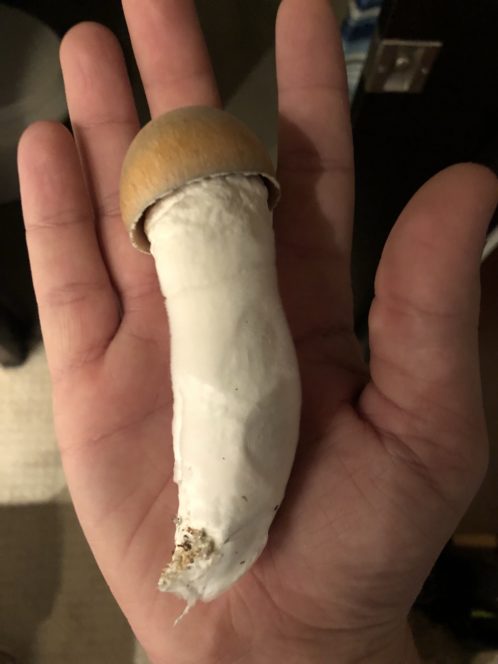
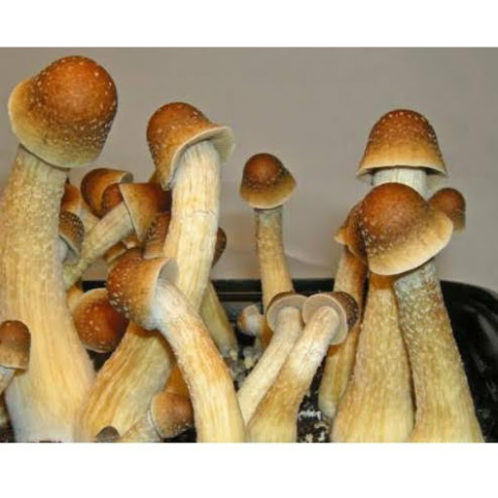
Penis Envy Spores
$19.98 – $217.50Penis Envy Spores
Penis Envy Spores, mushrooms and their spores are rare. Potent and sought after, these psilocybe cubensis magic mushrooms are a real gem. Spores from the Penis Envy Spores mushroom are available here at SporeStore.com because you asked for them! Find both mushroom spore syringe and also mushroom spore prints. This psilocybe cubensis magic mushroom was first discovered on a farm growing in a pile of dung and straw as its mushroom substrate in Colombia. There is no psilocybin or psilocin contained within magic mushroom spores, making them completely legal to purchase and possess in most jurisdictions throughout the USA. Make sure to check your local laws before ordering or growing mushrooms. The original Penis Envy Spores mushroom spores’ genetics in both spore print and spore syringe from the true Mushroom Spores Penis Envy Spores psilocybe cubensis mushrooms from Colombia are brought to you by SporeStore.com, the leader in mushroom spores.
Spores from this strain are rare and it’s NOT a decent spore depositor.
Penis Envy Spores magic mushrooms are easy to grow. Check your local mushroom growing laws. Growing mushrooms for identification and taxonomy purposes? We have your spores!
In addition to the Mushroom Spores Penis Envy Spores, here are some other mushroom spores that you may be interested in reviewing: Golden Teacher Spores mushroom magic spores, B+ mushroom spores which is also called B Plus mushroom spores, PES Amazonian mushroom spores, PES Hawaiian mushroom spores, Ecuador spores
Furthermore check out our new Mushroom Grinder!
Mushroom Capsules found here…
More Detail:
Habitat: Bovine, Equine Dung and Enriched Soils
Climate: Subtropical
Strain Origin: Colombia, South America
Cap: 50+ mm in diameter, campanulate, golden brown to yellow. Surface dry and lacks remnants of universal veil on cap (spots). Flesh white soon bruising bluish green. The caps do not develop normally and suffer diminished spore production. Due to the fact that only 10-25% of the mushrooms produced visible spore prints and laboratories can only produce a few large specimens, spores are difficult to acquire in volume.
Stem: 125-275 mm in length, contorted often bulbous near the middle, pale yellow to buff. Flesh bruising bluish green where injured. No persistent annulus but an annular zone can be distinguished on the stems surface.
Gills: Attachment adnate to adnexed, very close, underdeveloped. Grayish coloration in young fruit bodies that darkens slightly in age.
Spores: Few but dark purplish brown in volume, subellipsoid on 4-spored basidia
Comments: Spores are from a source culture subjected to a 3+ week heat therapy regime designed to eliminate viral infections in Agaricus bisporus. Although there was no “hard” evidence that the Penis Envy strain was ever infected with a virus, the therapy appears to have had some positive effects. Unfortunately, spore production is not noticeably improved.
-
Sale!
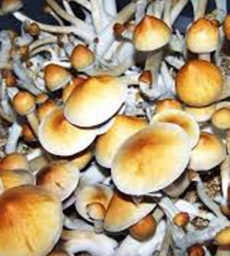
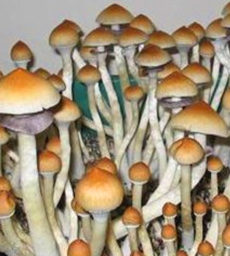
Alacabenzi Spores
$19.98 – $217.50Alacabenzi Spores
Alacabenzi Spores, mushrooms and their spores are rare. Potent and sought after, these psilocybe cubensis magic mushrooms are a real gem. Spores from the Alacabenzi Spores mushroom are available here at SporeStore.com because you asked for them! Find both mushroom spore syringe and also mushroom spore prints. This psilocybe cubensis magic mushroom was first discovered on a farm growing in a pile of dung and straw as its mushroom substrate in Alabama. There is no psilocybin or psilocin contained within magic mushroom spores, making them completely legal to purchase and possess in most jurisdictions throughout the USA. Make sure to check your local laws before ordering or growing mushrooms. The original Alacabenzi Spores mushroom spores’ genetics in both spore print and spore syringe from the true Mushroom Spores Alcabenzi psilocybe cubensis mushrooms from Alabama are brought to you by SporeStore.com, the leader in mushroom spores.
Spores from this strain are rare and it’s a decent spore depositor.
Alacabenzi Spores magic mushrooms are easy to grow. Check your local mushroom growing laws. Growing mushrooms for identification and taxonomy purposes? We have your spores!
In addition to the Mushroom Spores Alcabenzi spores, here are some other mushroom spores that you may be interested in reviewing: Golden Teacher Spores mushroom magic spores, B+ mushroom spores which is also called B Plus mushroom spores, PES Amazonian mushroom spores, PES Hawaiian mushroom spores, Ecuador spores
Furthermore check out our new Mushroom Grinder!
Mushroom Capsules found here…
More Detail:
Habitat: Bovine, Equine Dung and Enriched Soils
Climate: Subtropical
Strain Origin: Unknown
Cap: 45+ mm in diameter, convex to broadly convex to plane at maturity. Reddish cinnamon brown maturing to golden brown to light yellow because the surface is dry with pronounced and persistent remnants of universal veil on cap (spots) and the flesh is white soon bruising bluish green.
Stem: 120+ mm in length, yellowish. Flesh bruising bluish green where injured. Persistent membranous annulus (ring) from partial veil that becomes dusted with purple brown spores at maturity.
Gills: Attachment adnate to adnexed. Grayish coloration in young fruit bodies becoming nearly black in maturity.
Spores: Dark purplish brown, subellipsoid on 4-spored basidia
An extremely reliable strain that has aggressive mycelium growth and a stronger resistance to most common contaminations.
This psilocybe cubensis mushroom strain first appeared around 2001. From what we know the origins include a blend of genetics from an alabama strain and the classic “mexican cabenzi” strain.
Alacabenzi is proven to produce consistent results. With every experiment and is a great specimen for microscopy research or budding mycologists.
-
Sale!
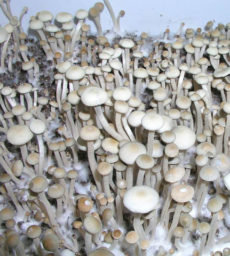
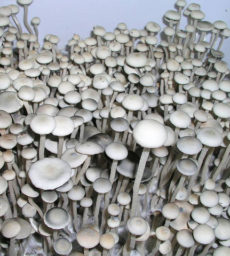
Jamaica Spores
$19.98 – $217.50Jamaica Spores
Jamaica Spores mushrooms and their spores are also some of the most sought after psilocybe cubensis magic mushrooms ever found. Spores from the Jamaica Spores mushroom are available here at SporeStore.com because you asked for them! Find both mushroom spore syringe and also mushroom spore prints. This psilocybe cubensis magic mushroom was first discovered on a farm growing in a pile of dung and straw as its mushroom substrate in Westmoreland. There is no psilocybin or psilocin contained within magic mushroom spores, making them completely legal to purchase and posses in most jurisdictions throughout the USA. As well as make sure to check your local laws before ordering. The original Jamaica Spores mushroom spores’ genetics from the true Jamaica Spores psilocybe cubensis mushrooms from Westmoreland are brought to you by SporeStore.com, the leader in mushroom spores.
Spores from this strain are extremely rare in the marketplace and here is a short guide on how to grow mushrooms.
Jamaica Spores magic mushrooms are easy to grow. Check your local mushroom growing laws. Growing mushrooms for identification and taxonomy purposes? We have your spores!
In addition to the Jamaica Spores spores, here are some other mushroom spores that you may be interested in reviewing: Alcabenzi mushroom magic spores, B+ mushroom spores which is also called B Plus mushroom spores, PES Amazonian mushroom spores, PES Hawaiian mushroom spores, Ecuador spores
Furthermore check out our new Mushroom Grinder!
Mushroom Capsules found here…
More Detail:
Habitat: Bovine, Equine Dung and Enriched Soils
Climate: Tropical
Strain Origin: Jamaica
Storage: Store in a dark, cool and dry place and use within six months after delivery!
Taxonomy:
Kingdom: Fungi
Division: Basidiomycota
Class: Agaricomycetes
Order: Agaricales
Family: Strophariaceae
Genus: Psilocybe
Spores: purplish brown to dark brown, 11.5 – 17 x 8 – 11 µm, ellipsoidHabitat and distribution in nature:
Rye grain, wheat straw, horse or cow manure. This species can be found in the subtropical and tropical climate zones all around the globe under the following conditions: Spawn run: 28 °C | Primordia formation: 23.3 – 25.6 °C | Fruiting: 23 – 26 °C
Origin: Westmoreland, Jamaica
There are several similar species of Copelandia, most differing from each other only microscopically. The strains offered here are probably cyanescens, but they have not been indentified with any certainty.
-
Sale!
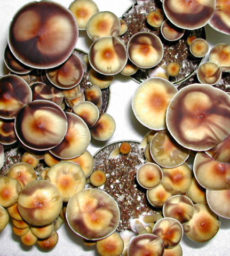
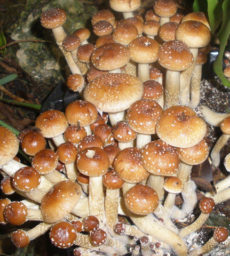
Keeper’s Creepers Spores
$19.98 – $217.50Keeper’s Creepers Spores
Keeper’s Creepers Spores mushrooms and their spores are also some of the most sought after psilocybe cubensis magic mushrooms ever found. Spores from the Keeper’s Creepers Spores mushroom are available here at SporeStore.com because you asked for them! Find both mushroom spore syringe and also mushroom spore prints. This psilocybe cubensis magic mushroom was first discovered on a farm growing in a pile of dung and straw as its mushroom substrate in Hawaii by none other than the original Keeper himself while on vacation on Maui. There is no psilocybin or psilocin contained within magic mushroom spores, making them completely legal to purchase and posses in most jurisdictions throughout the USA. Make sure to check your local laws before ordering. The original Keeper’s Creepers Spores mushroom spores’ genetics from the true Keeper’s Creepers Spores psilocybe cubensis mushrooms from Hawaii are brought to you by SporeStore.com, the leader in mushroom spores.
Spores from this strain are in abundance as it’s a healthy spore depositor.
Keeper’s Creepers Spores magic mushrooms are easy to grow. Check your local mushroom growing laws. Growing mushrooms for identification and taxonomy purposes? We have your spores!
In addition to the Keeper’s Creepers Spores spores, here are some other mushroom spores that you may be interested in reviewing: Alcabenzi mushroom magic spores, B+ mushroom spores which is also called B Plus mushroom spores, PES Amazonian mushroom spores, PES Hawaiian mushroom spores, Ecuador spores
Furthermore check out our new Mushroom Grinder!
Mushroom Capsules found here…
More Detail:
Habitat: Bovine, Equine Dung and Enriched Soils
Climate: Subtropical
Strain Origin: Unknown
Cap: 35+ mm in diameter, convex to broadly convex to plane at maturity. Reddish cinnamon brown maturing to golden brown to light yellow because the surface is dry with pronounced and persistent remnants of universal veil on cap (spots) and the flesh is white soon bruising bluish green.
Stem: 120+ mm in length, yellowish. Flesh bruising bluish green where injured. Persistent membranous annulus (ring) from partial veil that becomes dusted with purple brown spores at maturity.
Gills: Attachment adnate to adnexed. Grayish coloration in young fruit bodies becoming nearly black in maturity.
Spores: Dark purplish brown, subellipsoid on 4-spored basidia
Photo from the Keeper’s Collection
Storage: Store in a dark, cool and dry place and use within six months after delivery!
Taxonomy:
Kingdom: Fungi
Division: Basidiomycota
Class: Agaricomycetes
Order: Agaricales
Family: Strophariaceae
Genus: Psilocybe
Spores: purplish brown to dark brown, 11.5 – 17 x 8 – 11 µm, ellipsoidHabitat and distribution in nature:
Rye grain, wheat straw, horse or cow manure. This species can be found in the subtropical and tropical climate zones all around the globe under the following conditions: Spawn run: 28 °C | Primordia formation: 23.3 – 25.6 °C | Fruiting: 23 – 26 °C
-
Sale!
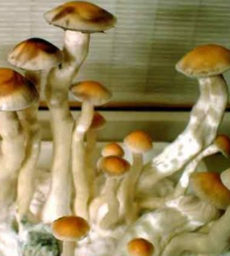
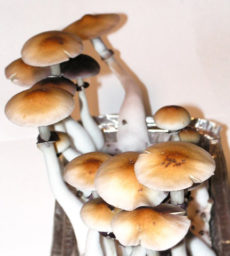
South Africa Transkei Spores
$19.98 – $217.50South Africa Transkei Spores
South Africa Transkei Spores mushrooms and their spores are also some of the most sought after psilocybe cubensis magic mushrooms ever found. Spores from the South Africa Transkei Spores mushroom are available here at SporeStore.com because you asked for them! Find both mushroom spore syringe and also mushroom spore prints. This psilocybe cubensis magic mushroom was first discovered on a farm growing in a pile of dung and straw as its mushroom substrate in the Transkei region of South Africa. There is no psilocybin or psilocin contained within magic mushroom spores, making them completely legal to purchase and posses in most jurisdictions throughout the USA. As well as make sure to check your local laws before ordering. The original South Africa Transkei Spores mushroom spores’ genetics from the true South Africa Transkei Spores psilocybe cubensis mushrooms from Transkei – South Africa are brought to you by SporeStore.com, the leader in mushroom spores.
Spores from this strain are in abundance as it’s a healthy spore depositor.
South Africa Transkei Spores magic mushrooms are easy to grow. Check your local mushroom growing laws. Growing mushrooms for identification and taxonomy purposes? We have your spores!
In addition to the South Africa Transkei Spores spores, here are some other mushroom spores that you may be interested in reviewing: Alcabenzi mushroom magic spores, B+ mushroom spores which is also called B Plus mushroom spores, PES Amazonian mushroom spores, PES Hawaiian mushroom spores, Ecuador spores
Furthermore check out our new Mushroom Grinder!
Mushroom Capsules found here…
More Detail:
Habitat: Bovine, Equine Dung and Enriched Soils
Climate: Subtropical
Strain Origin: Unknown
Cap: 50+ mm in diameter, convex to broadly convex to plane at maturity. Reddish cinnamon brown maturing to golden brown to light yellow because the surface is dry with pronounced and persistent remnants of universal veil on cap (spots) and the flesh is white soon bruising bluish green.
Stem: 125+ mm in length, yellowish. Flesh bruising bluish green where injured. Persistent membranous annulus (ring) from partial veil that becomes dusted with purple brown spores at maturity.
Gills: Attachment adnate to adnexed. Grayish coloration in young fruit bodies becoming nearly black in maturity.
Spores: Dark purplish brown, subellipsoid on 4-spored basidia
Images at right illustrate laboratory produced Golden Teachers on cased cow manure. Photos supplied by our European research associates courtesy of Anno (thanks!).
Storage: Store in a dark, cool and dry place and use within six months after delivery!
Taxonomy:
Kingdom: Fungi
Division: Basidiomycota
Class: Agaricomycetes
Order: Agaricales
Family: Strophariaceae
Genus: Psilocybe
Spores: purplish brown to dark brown, 11.5 – 17 x 8 – 11 µm, ellipsoidHabitat and distribution in nature:
Rye grain, wheat straw, horse or cow manure. This species can be found in the subtropical and tropical climate zones all around the globe under the following conditions: Spawn run: 28 °C | Primordia formation: 23.3 – 25.6 °C | Fruiting: 23 – 26 °C
-
Sale!
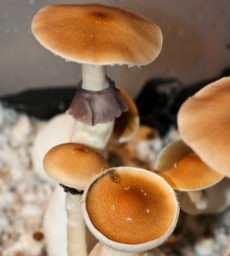
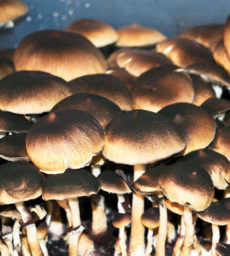
Malaysia Spores
$19.98 – $217.50Malaysia Spores
Malaysia Spores mushrooms and their spores are also some of the most sought after psilocybe cubensis magic mushrooms ever found. Spores from the Malaysia Spores mushroom are available here at SporeStore.com because you asked for them! Find both mushroom spore syringes and also mushroom spore prints. This psilocybe cubensis magic mushroom was first discovered on a farm growing in a pile of dung and straw as its mushroom substrate in Malaysia. There is no psilocybin or psilocin contained within magic mushroom spores, making them completely legal to purchase and posses in most jurisdictions throughout the USA. As well as make sure to check your local laws before ordering. The original Malaysia Spores mushroom spores’ genetics from the true Malaysia Spores psilocybe cubensis mushrooms from Malaysia are brought to you by SporeStore.com, the leader in mushroom spores.
Spores from this strain are in abundance as it’s a healthy spore depositor.
Malaysia Spores magic mushrooms are easy to grow. Check your local mushroom growing laws. Growing mushrooms for identification and taxonomy purposes? We have your spores!
In addition to the Malaysia Spores spores, here are some other mushroom spores that you may be interested in reviewing: Alcabenzi mushroom magic spores, B+ mushroom spores which is also called B Plus mushroom spores, PES Amazonian mushroom spores, PES Hawaiian mushroom spores, Ecuador spores
Furthermore check out our new Mushroom Grinder!
Mushroom Capsules found here…
More Detail:
Storage: Store in a dark, cool and dry place and use within six months after delivery!
Taxonomy:
Kingdom: Fungi
Division: Basidiomycota
Class: Agaricomycetes
Order: Agaricales
Family: Strophariaceae
Genus: Psilocybe
Spores: purplish brown to dark brown, 11.5 – 17 x 8 – 11 µm, ellipsoidHabitat and distribution in nature:
Rye grain, wheat straw, horse or cow manure. This species can be found in the subtropical and tropical climate zones all around the globe under the following conditions: Spawn run incubation: 28 °C | Primordia formation: 23.3 – 25.6 °C | Fruiting: 23 – 26 °C
Habitat: Bovine, Equine Dung and Enriched Soils
Climate: Subtropical
Strain Origin: Malaysia
Cap: 25-75 mm in diameter, hemispheric to convex expanding to broadly convex to nearly plane with age. Dark red maturing to golden brown. Surface viscid with apparent gelatinous layer when very wet, soon smooth from drying. Fine fibrillose veil remnants when young that soon disappear. Flesh white soon bruising bluish green.
Stem: 150-200+ mm in length. Typically equal, sometimes slightly enlarged at base, sometimes contorted. Yellowish to buff with a reflective sheen, bruising bluish, hollow. Partial veil membranous leaving a persistent membranous annulus that is well dusted with purplish brown spores even before tearing away from the cap.
Gills: Attachment adnate to adnexed. Grayish coloration in young fruit bodies becoming nearly black in maturity.
Spores: Dark purplish brown, subellipsoid, 13 by 8 micrometers on 4-spored basidia
-
Sale!
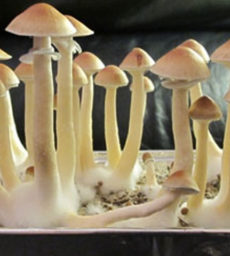
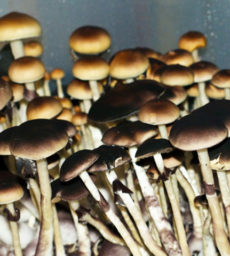
Z-Strain Spores
$19.98 – $217.50Z-Strain Spores
Z-Strain Spores mushrooms and their spores are also some of the most sought after psilocybe cubensis magic mushrooms ever found. Spores from the Z-Strain Spores mushroom are available here at SporeStore.com because you asked for them! Find both mushroom spore syringes and also mushroom spore prints. This psilocybe cubensis magic mushroom was first discovered on a farm growing in a pile of dung and straw as its mushroom substrate in Hawaii. There is no psilocybin or psilocin contained within magic mushroom spores, making them completely legal to purchase and posses in most jurisdictions throughout the USA. As well as make sure to check your local laws before ordering. The original Z-Strain Spores mushroom spores’ genetics from the true Z-Strain Spores psilocybe cubensis mushrooms from Hawaii are brought to you by SporeStore.com, the leader in mushroom spores.
Spores from this strain are in abundance as it’s a healthy spore depositor.
Z-Strain Spores magic mushrooms are easy to grow. Check your local mushroom growing laws. Growing mushrooms for identification and taxonomy purposes? We have your spores!
In addition to the Z-Strain Spores spores, here are some other mushroom spores that you may be interested in reviewing: Alcabenzi mushroom magic spores, B+ mushroom spores which is also called B Plus mushroom spores, PES Amazonian mushroom spores, PES Hawaiian mushroom spores, Ecuador spores
Furthermore check out our new Mushroom Grinder!
Mushroom Capsules found here…
More Detail:
Habitat: Bovine, Equine Dung and Enriched Soils
Climate: Tropical
Strain Origin: Unknown
Cap: 50+ mm in diameter, convex to broadly convex to plane at maturity. Reddish cinnamon brown maturing to golden brown to light yellow because the surface is dry with pronounced and persistent remnants of universal veil on cap (spots) and the flesh is white soon bruising bluish green.
Stem: 125+ mm in length, yellowish. Flesh bruising bluish green where injured. Persistent membranous annulus (ring) from partial veil that becomes dusted with purple brown spores at maturity.
Gills: Attachment adnate to adnexed. Grayish coloration in young fruit bodies becoming nearly black in maturity.
Spores: Dark purplish brown, subellipsoid on 4-spored basidia
Storage: Store in a dark, cool and dry place and use within six months after delivery!
Taxonomy:
Kingdom: Fungi
Division: Basidiomycota
Class: Agaricomycetes
Order: Agaricales
Family: Strophariaceae
Genus: Psilocybe
Spores: purplish brown to dark brown, 11.5 – 17 x 8 – 11 µm, ellipsoidHabitat and distribution in nature:
Rye grain, wheat straw, horse or cow manure. This species can be found in the subtropical and tropical climate zones all around the globe under the following conditions: Spawn run incubation: 28 °C | Primordia formation: 23.3 – 25.6 °C | Fruiting: 23 – 26 °C
Habitat: Bovine, Equine Dung and Enriched Soils
Climate: Subtropical
Strain Origin: Unknown
Cap: 25-75 mm in diameter, hemispheric to convex expanding to broadly convex to nearly plane with age. Dark red maturing to golden brown. Surface viscid with apparent gelatinous layer when very wet, soon smooth from drying. Fine fibrillose veil remnants when young that soon disappear. Flesh white soon bruising bluish green.
Stem: 150-200+ mm in length. Typically equal, sometimes slightly enlarged at base, sometimes contorted. Yellowish to buff with a reflective sheen, bruising bluish, hollow. Partial veil membranous leaving a persistent membranous annulus that is well dusted with purplish brown spores even before tearing away from the cap.
Gills: Attachment adnate to adnexed. Grayish coloration in young fruit bodies becoming nearly black in maturity.
Spores: Dark purplish brown, subellipsoid, 13 by 8 micrometers on 4-spored basidia
A 2011 study also found that more than a year after participants had a single psilocybin experience, their self-reported measures of openness remained significantly elevated, which researches in this study and beyond attribute to a somewhat mysterious but powerful aspect of a mushroom trip: the mystical experience.
In this case, a mystical experience is defined as “feelings of unity and interconnectedness with all people and things, a sense of sacredness, feelings of peace and joy, a sense of transcending normal time and space, ineffability, and an intuitive belief that the experience is a source of objective truth about the nature of reality.” The religious identification of people who have reported having a mystical-type experience during a mushroom trip span the spectrum, but interestingly the profundity of such experiences don’t seem to correlate to religious belief—even atheists have reported the importance of their psilocybin-induced mystical experiences. Additionally, research has shown that the more intense the mystical experience, the greater the positive, long-term changes a person sees.
These subjective effects, such as feelings of interconnectedness, are likely a result of psilocybin’s ability to decrease the interconnectivity of integration hubs in the brain. In plain speak, that means psilocybin allows for more “cross-talk” between regions of the brain that are typically segregated. Researchers speculate that this enables a state of “unconstrained cognition,” meaning the ways we typically organize, categorize, and differentiate the aspects of conscious experience are broken down, and thinking becomes more flexible. To understand how this might be beneficial, it helps to know that similar brain activity patterns are also observed during various states of meditation.
-
Sale!
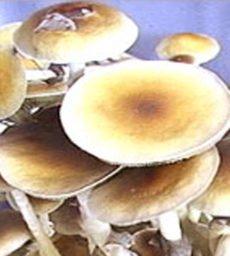
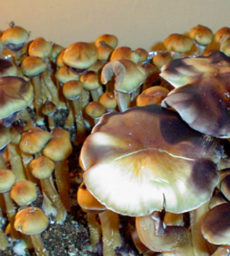
Hairy Buffalo Spores
$19.98 – $217.50Hairy Buffalo Spores
Hairy Buffalo Spores mushrooms and their spores are also some of the most sought after psilocybe cubensis magic mushrooms ever found. Spores from the Hairy Buffalo Spores mushroom are available here at SporeStore.com because you asked for them! Find both mushroom spore syringes and also mushroom spore prints. This psilocybe cubensis magic mushroom was first discovered on a farm growing in a pile of dung and straw as its mushroom substrate in Thailand. There is no psilocybin or psilocin contained within magic mushroom spores, making them completely legal to purchase and posses in most jurisdictions throughout the USA. As well as make sure to check your local laws before ordering. The original Hairy Buffalo Spores mushroom spores’ genetics from the true Hairy Buffalo Spores psilocybe cubensis mushrooms from Thailand are brought to you by SporeStore.com, the leader in mushroom spores.
Spores from this strain are in abundance as it’s a healthy spore depositor.
Hairy Buffalo Spores magic mushrooms are easy to grow. Check your local mushroom growing laws. Growing mushrooms for identification and taxonomy purposes? We have your spores!
In addition to the Hairy Buffalo Spores spores, here are some other mushroom spores that you may be interested in reviewing: Alcabenzi mushroom magic spores, B+ mushroom spores which is also called B Plus mushroom spores, PES Amazonian mushroom spores, PES Hawaiian mushroom spores, Ecuador spores
Furthermore check out our new Mushroom Grinder!
Mushroom Capsules found here…
More Detail:
Storage: Store in a dark, cool and dry place and use within six months after delivery!
Taxonomy:
Kingdom: Fungi
Division: Basidiomycota
Class: Agaricomycetes
Order: Agaricales
Family: Strophariaceae
Genus: Psilocybe
Spores: purplish brown to dark brown, 11.5 – 17 x 8 – 11 µm, ellipsoidHabitat and distribution in nature:
Rye grain, wheat straw, horse or cow manure. This species can be found in the subtropical and tropical climate zones all around the globe under the following conditions: Spawn run incubation: 28 °C | Primordia formation: 23.3 – 25.6 °C | Fruiting: 23 – 26 °C
A 2011 study also found that more than a year after participants had a single psilocybin experience, their self-reported measures of openness remained significantly elevated, which researches in this study and beyond attribute to a somewhat mysterious but powerful aspect of a mushroom trip: the mystical experience.
In this case, a mystical experience is defined as “feelings of unity and interconnectedness with all people and things, a sense of sacredness, feelings of peace and joy, a sense of transcending normal time and space, ineffability, and an intuitive belief that the experience is a source of objective truth about the nature of reality.” The religious identification of people who have reported having a mystical-type experience during a mushroom trip span the spectrum, but interestingly the profundity of such experiences don’t seem to correlate to religious belief—even atheists have reported the importance of their psilocybin-induced mystical experiences. Additionally, research has shown that the more intense the mystical experience, the greater the positive, long-term changes a person sees.
These subjective effects, such as feelings of interconnectedness, are likely a result of psilocybin’s ability to decrease the interconnectivity of integration hubs in the brain. In plain speak, that means psilocybin allows for more “cross-talk” between regions of the brain that are typically segregated. Researchers speculate that this enables a state of “unconstrained cognition,” meaning the ways we typically organize, categorize, and differentiate the aspects of conscious experience are broken down, and thinking becomes more flexible. To understand how this might be beneficial, it helps to know that similar brain activity patterns are also observed during various states of meditation.
Habitat: Bovine, Equine Dung and Enriched Soils
Climate: Subtropical
Strain Origin: Unknown
Cap: 25-75 mm in diameter, hemispheric to convex expanding to broadly convex to nearly plane with age. Dark red maturing to golden brown. Surface viscid with apparent gelatinous layer when very wet, soon smooth from drying. Fine fibrillose veil remnants when young that soon disappear. Flesh white soon bruising bluish green.
Stem: 150-200+ mm in length. Typically equal, sometimes slightly enlarged at base, sometimes contorted. Yellowish to buff with a reflective sheen, bruising bluish, hollow. Partial veil membranous leaving a persistent membranous annulus that is well dusted with purplish brown spores even before tearing away from the cap.
Gills: Attachment adnate to adnexed. Grayish coloration in young fruit bodies becoming nearly black in maturity.
Spores: Dark purplish brown, subellipsoid, 13 by 8 micrometers on 4-spored basidia
-
Sale!
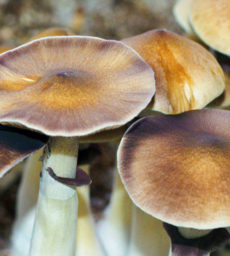
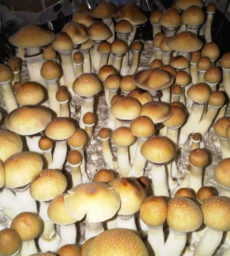
B+ Spores
$19.98 – $217.50B+ Spores
B+ Spores and their spores are some of the most sought after psilocybe cubensis magic mushrooms ever found. Spores from the B+ Spores are available here at SporeStore.com because you asked for them! Find both mushroom spore syringe and also mushroom spore prints. This psilocybe cubensis magic mushroom was first discovered on a farm growing in a pile of dung and straw as its mushroom substrate in Florida. There is no psilocybin or psilocin contained within magic mushroom spores, making them completely legal to purchase and posses in most jurisdictions throughout the USA. As well as make sure to check your local laws before ordering. The original B+ Spores‘ genetics from the true B+ Spores psilocybe cubensis mushrooms from Florida are broughtt to you by SporeStore.com, the leader in mushroom spores.
Spores from this strain are in abundance as it’s a healthy spore depositor.
B+ Spores magic mushrooms are easy to grow. Check your local mushroom growing laws. Growing mushrooms for identification and taxonomy purposes? We have your spores!
In addition to the B+ Spores spores, here are some other mushroom spores that you may be interested in reviewing: Alcabenzi mushroom magic spores, Golden Teachers Shrooms mushroom spores which is also called B Plus mushroom spores, PES Amazonian mushroom spores, PES Hawaiian mushroom spores, Ecuador spores
Furthermore check out our new Mushroom Grinder!
Mushroom Capsules found here…
More Detail:
Habitat: Bovine, Equine Dung and Enriched Soils
Climate: Subtropical
Strain Origin: Unknown
Cap: 25-75 mm in diameter, hemispheric to convex expanding to broadly convex to nearly plane with age. Dark red maturing to golden brown. Surface viscid with apparent gelatinous layer when very wet, soon smooth from drying. Fine fibrillose veil remnants when young that soon disappear. Flesh white soon bruising bluish green.
Stem: 150-200+ mm in length. Typically equal, sometimes slightly enlarged at base, sometimes contorted. Yellowish to buff with a reflective sheen, bruising bluish, hollow. Partial veil membranous leaving a persistent membranous annulus that is well dusted with purplish brown spores even before tearing away from the cap.
Gills: Attachment adnate to adnexed. Grayish coloration in young fruit bodies becoming nearly black in maturity.
Spores: Dark purplish brown, subellipsoid, 13 by 8 micrometers on 4-spored basidia
Formerly misrepresented as Psilocybe azurescens.
Detail of separable gelatinous pellicle: This feature seems to be unique to the “B+” among cubensis. When young and fully hydrated the cap has a transparent amber colored layer of cells that quickly oxidizes upon removal to a more opaque blue gray color. The texture is like a thin stretchable layer of gelatin. Note the area where the pellicle has been removed is dull.
A 2011 study also found that more than a year after participants had a single psilocybin experience, their self-reported measures of openness remained significantly elevated, which researches in this study and beyond attribute to a somewhat mysterious but powerful aspect of a mushroom trip: the mystical experience.
In this case, a mystical experience is defined as “feelings of unity and interconnectedness with all people and things, a sense of sacredness, feelings of peace and joy, a sense of transcending normal time and space, ineffability, and an intuitive belief that the experience is a source of objective truth about the nature of reality.” The religious identification of people who have reported having a mystical-type experience during a mushroom trip span the spectrum, but interestingly the profundity of such experiences don’t seem to correlate to religious belief—even atheists have reported the importance of their psilocybin-induced mystical experiences. Additionally, research has shown that the more intense the mystical experience, the greater the positive, long-term changes a person sees.
These subjective effects, such as feelings of interconnectedness, are likely a result of psilocybin’s ability to decrease the interconnectivity of integration hubs in the brain. In plain speak, that means psilocybin allows for more “cross-talk” between regions of the brain that are typically segregated. Researchers speculate that this enables a state of “unconstrained cognition,” meaning the ways we typically organize, categorize, and differentiate the aspects of conscious experience are broken down, and thinking becomes more flexible. To understand how this might be beneficial, it helps to know that similar brain activity patterns are also observed during various states of meditation.
-
Sale!
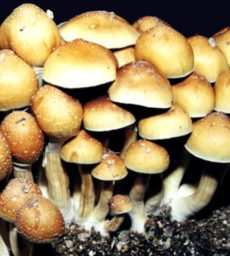
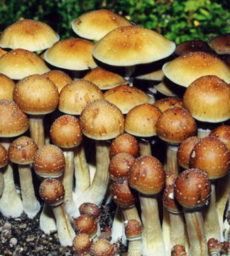
Plantasia Mystery Spores
$19.98 – $217.50Plantasia Mystery Spores
Plantasia Mystery Spores mushrooms and their spores are also some of the most sought after psilocybe cubensis magic mushrooms ever found. Spores from the Plantasia Mystery Spores mushroom are available here at SporeStore.com because you asked for them! Find both mushroom spore syringes and also mushroom spore prints. This psilocybe cubensis magic mushroom was first discovered on a farm growing in a pile of dung and straw as its mushroom substrate in Vietnam. There is no psilocybin or psilocin contained within magic mushroom spores, making them completely legal to purchase and posses in most jurisdictions throughout the USA. As well as make sure to check your local laws before ordering. The original Plantasia Mystery Spores mushroom spores’ genetics from the true Plantasia Mystery Spores psilocybe cubensis mushrooms from Vietnam are brought to you by SporeStore.com, the leader in mushroom spores.
Spores from this strain are in abundance as it’s a healthy spore depositor.
Plantasia Mystery Spores magic mushrooms are easy to grow. Check your local mushroom growing laws. Growing mushrooms for identification and taxonomy purposes? We have your spores!
In addition to the Plantasia Mystery Spores spores, here are some other mushroom spores that you may be interested in reviewing: Alcabenzi mushroom magic spores, B+ mushroom spores which is also called B Plus mushroom spores, PES Amazonian mushroom spores, PES Hawaiian mushroom spores, Ecuador spores
Furthermore check out our new Mushroom Grinder!
Mushroom Capsules found here…
More Detail:
Habitat: Bovine, Equine Dung and Enriched Soils
Climate: Tropical
Strain Origin: Unknown
Cap: 50+ mm in diameter, convex to broadly convex to plane at maturity. Reddish cinnamon brown maturing to golden brown to light yellow because the surface is dry with pronounced and persistent remnants of universal veil on cap (spots) and the flesh is white soon bruising bluish green.
Stem: 125+ mm in length, yellowish. Flesh bruising bluish green where injured. Persistent membranous annulus (ring) from partial veil that becomes dusted with purple brown spores at maturity.
Gills: Attachment adnate to adnexed. Grayish coloration in young fruit bodies becoming nearly black in maturity.
Spores: Dark purplish brown, subellipsoid on 4-spored basidia
Storage: Store in a dark, cool and dry place and use within six months after delivery!
Taxonomy:
Kingdom: Fungi
Division: Basidiomycota
Class: Agaricomycetes
Order: Agaricales
Family: Strophariaceae
Genus: Psilocybe
Spores: purplish brown to dark brown, 11.5 – 17 x 8 – 11 µm, ellipsoidHabitat and distribution in nature:
Rye grain, wheat straw, horse or cow manure. This species can be found in the subtropical and tropical climate zones all around the globe under the following conditions: Spawn run incubation: 28 °C | Primordia formation: 23.3 – 25.6 °C | Fruiting: 23 – 26 °C
A 2011 study also found that more than a year after participants had a single psilocybin experience, their self-reported measures of openness remained significantly elevated, which researches in this study and beyond attribute to a somewhat mysterious but powerful aspect of a mushroom trip: the mystical experience.
In this case, a mystical experience is defined as “feelings of unity and interconnectedness with all people and things, a sense of sacredness, feelings of peace and joy, a sense of transcending normal time and space, ineffability, and an intuitive belief that the experience is a source of objective truth about the nature of reality.” The religious identification of people who have reported having a mystical-type experience during a mushroom trip span the spectrum, but interestingly the profundity of such experiences don’t seem to correlate to religious belief—even atheists have reported the importance of their psilocybin-induced mystical experiences. Additionally, research has shown that the more intense the mystical experience, the greater the positive, long-term changes a person sees.
These subjective effects, such as feelings of interconnectedness, are likely a result of psilocybin’s ability to decrease the interconnectivity of integration hubs in the brain. In plain speak, that means psilocybin allows for more “cross-talk” between regions of the brain that are typically segregated. Researchers speculate that this enables a state of “unconstrained cognition,” meaning the ways we typically organize, categorize, and differentiate the aspects of conscious experience are broken down, and thinking becomes more flexible. To understand how this might be beneficial, it helps to know that similar brain activity patterns are also observed during various states of meditation.
Were very happy to be able to bring this strain to you. As you can see from some of the outdoor pics, it looks a lot like an ps. azurescens, but it is a cubensis. Its very adaptable to many climates and does very well in extreme heat! It loves warm temperatures making it a great summer mushroom.
-
Sale!
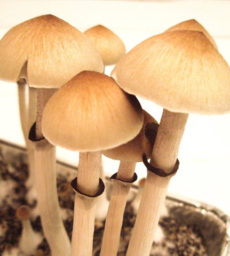
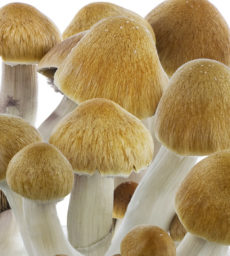
Ecuador Spores
$19.98 – $217.50Ecuador Spores
Ecuador Spores mushrooms and their spores are also some of the most sought after psilocybe cubensis magic mushrooms ever found. Spores from the Ecuador Spores mushroom are available here at SporeStore.com because you asked for them! Find both mushroom spore syringes and also mushroom spore prints. This psilocybe cubensis magic mushroom was first discovered on a farm growing in a pile of dung and straw as its mushroom substrate in Ecuador. There is no psilocybin or psilocin contained within magic mushroom spores, making them completely legal to purchase and posses in most jurisdictions throughout the USA. As well as make sure to check your local laws before ordering. The original Ecuador Spores mushroom spores’ genetics from the true Ecuador Spores psilocybe cubensis mushrooms from Ecuador are brought to you by SporeStore.com, the leader in mushroom spores.
Spores from this strain are in abundance as it’s a healthy spore depositor.
Ecuador Spores magic mushrooms are easy to grow. Check your local mushroom growing laws. Growing mushrooms for identification and taxonomy purposes? We have your spores!
In addition to the Ecuador Spores spores, here are some other mushroom spores that you may be interested in reviewing: Alcabenzi mushroom magic spores, B+ mushroom spores which is also called B Plus mushroom spores, PES Amazonian mushroom spores, PES Hawaiian mushroom spores, Malaysia spores
Furthermore check out our new Mushroom Grinder!
Mushroom Capsules found here…
More Detail:
Habitat: Bovine, Equine Dung and Enriched Soils
Climate: Subtropical
Strain Origin: Unknown
Cap: 50+ mm in diameter, convex to broadly convex to plane at maturity. Reddish cinnamon brown maturing to golden brown to light yellow because the surface is dry with pronounced and persistent remnants of universal veil on cap (spots) and the flesh is white soon bruising bluish green.
Stem: 125+ mm in length, yellowish. Flesh bruising bluish green where injured. Persistent membranous annulus (ring) from partial veil that becomes dusted with purple brown spores at maturity.
Gills: Attachment adnate to adnexed. Grayish coloration in young fruit bodies becoming nearly black in maturity.
Spores: Dark purplish brown, subellipsoid on 4-spored basidia
Storage: Store in a dark, cool and dry place and use within six months after delivery!
Taxonomy:
Kingdom: Fungi
Division: Basidiomycota
Class: Agaricomycetes
Order: Agaricales
Family: Strophariaceae
Genus: Psilocybe
Spores: purplish brown to dark brown, 11.5 – 17 x 8 – 11 µm, ellipsoidHabitat and distribution in nature:
Rye grain, wheat straw, horse or cow manure. This species can be found in the subtropical and tropical climate zones all around the globe under the following conditions: Spawn run incubation: 28 °C | Primordia formation: 23.3 – 25.6 °C | Fruiting: 23 – 26 °C
A 2011 study also found that more than a year after participants had a single psilocybin experience, their self-reported measures of openness remained significantly elevated, which researches in this study and beyond attribute to a somewhat mysterious but powerful aspect of a mushroom trip: the mystical experience.
In this case, a mystical experience is defined as “feelings of unity and interconnectedness with all people and things, a sense of sacredness, feelings of peace and joy, a sense of transcending normal time and space, ineffability, and an intuitive belief that the experience is a source of objective truth about the nature of reality.” The religious identification of people who have reported having a mystical-type experience during a mushroom trip span the spectrum, but interestingly the profundity of such experiences don’t seem to correlate to religious belief—even atheists have reported the importance of their psilocybin-induced mystical experiences. Additionally, research has shown that the more intense the mystical experience, the greater the positive, long-term changes a person sees.
These subjective effects, such as feelings of interconnectedness, are likely a result of psilocybin’s ability to decrease the interconnectivity of integration hubs in the brain. In plain speak, that means psilocybin allows for more “cross-talk” between regions of the brain that are typically segregated. Researchers speculate that this enables a state of “unconstrained cognition,” meaning the ways we typically organize, categorize, and differentiate the aspects of conscious experience are broken down, and thinking becomes more flexible. To understand how this might be beneficial, it helps to know that similar brain activity patterns are also observed during various states of meditation.
Habitat: Bovine, Equine Dung and Enriched Soils
Climate: Subtropical
Strain Origin: Ecuador
Cap: 50-75 mm in diameter, convex to broadly convex to plane with obtuse umbo at maturity. Dark reddish cinnamon brown maturing to golden brown. Surface dry with pronounced and persistent remnants of universal veil on cap (spots). Flesh white soon bruising bluish green.
Stem: 200+ mm in length, pale yellowish to buff. Flesh bruising bluish green where injured. Persistent membranous annulus (ring) from partial veil that becomes dusted with purple brown spores at maturity.
Gills: Attachment adnate to adnexed. Grayish coloration in young fruit bodies becoming nearly black in maturity.
Spores: Dark purplish brown, subellipsoid on 4-spored basidia.
-
Sale!
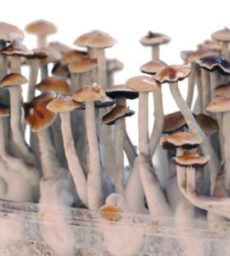
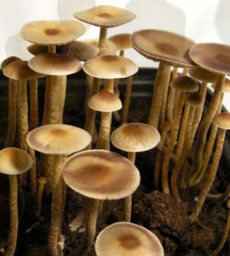
Oasis Spores
$19.98 – $217.50Oasis Spores
Oasis Spores mushrooms and their spores are also some of the most sought after psilocybe cubensis magic mushrooms ever found. Spores from the Oasis Spores mushroom are available here at SporeStore.com because you asked for them! Find both mushroom spore syringes and also mushroom spore prints. This psilocybe cubensis magic mushroom was first discovered on a farm growing in a pile of dung and straw as its mushroom substrate in Brazil. There is no psilocybin or psilocin contained within magic mushroom spores, making them completely legal to purchase and posses in most jurisdictions throughout the USA. As well as make sure to check your local laws before ordering. The original Oasis Spores mushroom spores’ genetics from the true Oasis Spores psilocybe cubensis mushrooms from Brazil are brought to you by SporeStore.com, the leader in mushroom spores.
Spores from this strain are in abundance as it’s a healthy spore depositor.
Oasis Spores magic mushrooms are easy to grow. Check your local mushroom growing laws. Growing mushrooms for identification and taxonomy purposes? We have your spores!
In addition to the Oasis Spores spores, here are some other mushroom spores that you may be interested in reviewing: Alcabenzi mushroom magic spores, B+ mushroom spores which is also called B Plus mushroom spores, Malaysia Spores mushroom spores, PES Hawaiian mushroom spores, Ecuador spores
Furthermore check out our new Mushroom Grinder!
Mushroom Capsules found here…
More Detail:
Habitat: Bovine, Equine Dung and Enriched Soils
Climate: Subtropical
Strain Origin: Unknown
Cap: 50+ mm in diameter, convex to broadly convex to plane at maturity. Reddish cinnamon brown maturing to golden brown to light yellow because the surface is dry with pronounced and persistent remnants of universal veil on cap (spots) and the flesh is white soon bruising bluish green.
Stem: 125+ mm in length, yellowish. Flesh bruising bluish green where injured. Persistent membranous annulus (ring) from partial veil that becomes dusted with purple brown spores at maturity.
Gills: Attachment adnate to adnexed. Grayish coloration in young fruit bodies becoming nearly black in maturity.
Spores: Dark purplish brown, subellipsoid on 4-spored basidia
Storage: Store in a dark, cool and dry place and use within six months after delivery!
Taxonomy:
Kingdom: Fungi
Division: Basidiomycota
Class: Agaricomycetes
Order: Agaricales
Family: Strophariaceae
Genus: Psilocybe
Spores: purplish brown to dark brown, 11.5 – 17 x 8 – 11 µm, ellipsoidHabitat and distribution in nature:
Rye grain, wheat straw, horse or cow manure. This species can be found in the subtropical and tropical climate zones all around the globe under the following conditions: Spawn run incubation: 28 °C | Primordia formation: 23.3 – 25.6 °C | Fruiting: 23 – 26 °C
A 2011 study also found that more than a year after participants had a single psilocybin experience, their self-reported measures of openness remained significantly elevated, which researches in this study and beyond attribute to a somewhat mysterious but powerful aspect of a mushroom trip: the mystical experience.
In this case, a mystical experience is defined as “feelings of unity and interconnectedness with all people and things, a sense of sacredness, feelings of peace and joy, a sense of transcending normal time and space, ineffability, and an intuitive belief that the experience is a source of objective truth about the nature of reality.” The religious identification of people who have reported having a mystical-type experience during a mushroom trip span the spectrum, but interestingly the profundity of such experiences don’t seem to correlate to religious belief—even atheists have reported the importance of their psilocybin-induced mystical experiences. Additionally, research has shown that the more intense the mystical experience, the greater the positive, long-term changes a person sees.
These subjective effects, such as feelings of interconnectedness, are likely a result of psilocybin’s ability to decrease the interconnectivity of integration hubs in the brain. In plain speak, that means psilocybin allows for more “cross-talk” between regions of the brain that are typically segregated. Researchers speculate that this enables a state of “unconstrained cognition,” meaning the ways we typically organize, categorize, and differentiate the aspects of conscious experience are broken down, and thinking becomes more flexible. To understand how this might be beneficial, it helps to know that similar brain activity patterns are also observed during various states of meditation.
Habitat: Bovine, Equine Dung and Enriched Soils
Climate: Subtropical
Strain Origin: Unclear, possibly the Amazon as the name suggests. PES stock (Pacific Exotica Spora)
Cap: 25-50+ mm in diameter, convex to broadly convex to plane at maturity often with persistent acute umbo (nipple). Reddish cinnamon brown maturing to golden brown to light yellow with nearly white edges. Surface dry lacking remnants of universal veil on cap (spots). Flesh white soon bruising bluish green.
Stem: 150+ mm in length, yellowish. Flesh bruising bluish green where injured. Persistent membranous annulus (ring) from partial veil that becomes dusted with purple brown spores at maturity.
Gills: Attachment adnate to adnexed. Grayish coloration in young fruit bodies becoming nearly black in maturity.
Spores: Dark purplish brown, subellipsoid on 4-spored basidia
-
Sale!
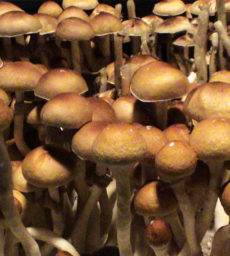
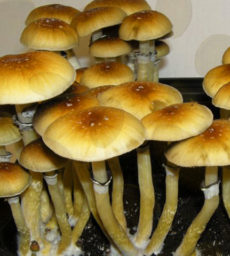
PES Amazonian Spores
$19.98 – $217.50PES Amazonian Spores
PES Amazonian Spores mushrooms and their spores are also some of the most sought after psilocybe cubensis magic mushrooms ever found. Spores from the PES Amazonian Spores mushroom are available here at SporeStore.com because you asked for them! Find both mushroom spore syringes and also mushroom spore prints. This psilocybe cubensis magic mushroom was first discovered on a farm growing in a pile of dung and straw as its mushroom substrate in Brazil. There is no psilocybin or psilocin contained within magic mushroom spores, making them completely legal to purchase and posses in most jurisdictions throughout the USA. As well as make sure to check your local laws before ordering. The original PES Amazonian Spores mushroom spores’ genetics from the true PES Amazonian Spores psilocybe cubensis mushrooms from Brazil are brought to you by SporeStore.com, the leader in mushroom spores.
Spores from this strain are in abundance as it’s a healthy spore depositor.
PES Amazonian Spores magic mushrooms are easy to grow. Check your local mushroom growing laws. Growing mushrooms for identification and taxonomy purposes? We have your spores!
In addition to the PES Amazonian Spores spores, here are some other mushroom spores that you may be interested in reviewing: Alacabenzi mushroom magic spores, B+ mushroom spores which is also called B Plus mushroom spores, Malaysia Spores mushroom spores, PES Hawaiian mushroom spores, Ecuador spores
Furthermore check out our new Mushroom Grinder!
Mushroom Capsules found here…
More Detail:
Habitat: Bovine, Equine Dung and Enriched Soils
Climate: Subtropical
Strain Origin: Unknown
Cap: 50+ mm in diameter, convex to broadly convex to plane at maturity. Reddish cinnamon brown maturing to golden brown to light yellow because the surface is dry with pronounced and persistent remnants of universal veil on cap (spots) and the flesh is white soon bruising bluish green.
Stem: 125+ mm in length, yellowish. Flesh bruising bluish green where injured. Persistent membranous annulus (ring) from partial veil that becomes dusted with purple brown spores at maturity.
Gills: Attachment adnate to adnexed. Grayish coloration in young fruit bodies becoming nearly black in maturity.
Spores: Dark purplish brown, subellipsoid on 4-spored basidia
Storage: Store in a dark, cool and dry place and use within six months after delivery!
Taxonomy:
Kingdom: Fungi
Division: Basidiomycota
Class: Agaricomycetes
Order: Agaricales
Family: Strophariaceae
Genus: Psilocybe
Spores: purplish brown to dark brown, 11.5 – 17 x 8 – 11 µm, ellipsoidHabitat and distribution in nature:
Rye grain, wheat straw, horse or cow manure. This species can be found in the subtropical and tropical climate zones all around the globe under the following conditions: Spawn run incubation: 28 °C | Primordia formation: 23.3 – 25.6 °C | Fruiting: 23 – 26 °C
A 2011 study also found that more than a year after participants had a single psilocybin experience, their self-reported measures of openness remained significantly elevated, which researches in this study and beyond attribute to a somewhat mysterious but powerful aspect of a mushroom trip: the mystical experience.
In this case, a mystical experience is defined as “feelings of unity and interconnectedness with all people and things, a sense of sacredness, feelings of peace and joy, a sense of transcending normal time and space, ineffability, and an intuitive belief that the experience is a source of objective truth about the nature of reality.” The religious identification of people who have reported having a mystical-type experience during a mushroom trip span the spectrum, but interestingly the profundity of such experiences don’t seem to correlate to religious belief—even atheists have reported the importance of their psilocybin-induced mystical experiences. Additionally, research has shown that the more intense the mystical experience, the greater the positive, long-term changes a person sees.
These subjective effects, such as feelings of interconnectedness, are likely a result of psilocybin’s ability to decrease the interconnectivity of integration hubs in the brain. In plain speak, that means psilocybin allows for more “cross-talk” between regions of the brain that are typically segregated. Researchers speculate that this enables a state of “unconstrained cognition,” meaning the ways we typically organize, categorize, and differentiate the aspects of conscious experience are broken down, and thinking becomes more flexible. To understand how this might be beneficial, it helps to know that similar brain activity patterns are also observed during various states of meditation.
Habitat: Bovine, Equine Dung and Enriched Soils
Climate: Subtropical
Strain Origin: Unclear, possibly the Amazon as the name suggests. PES stock (Pacific Exotica Spora)
Cap: 25-50+ mm in diameter, convex to broadly convex to plane at maturity often with persistent acute umbo (nipple). Reddish cinnamon brown maturing to golden brown to light yellow with nearly white edges. Surface dry lacking remnants of universal veil on cap (spots). Flesh white soon bruising bluish green.
Stem: 150+ mm in length, yellowish. Flesh bruising bluish green where injured. Persistent membranous annulus (ring) from partial veil that becomes dusted with purple brown spores at maturity.
Gills: Attachment adnate to adnexed. Grayish coloration in young fruit bodies becoming nearly black in maturity.
Spores: Dark purplish brown, subellipsoid on 4-spored basidia
-
Sale!

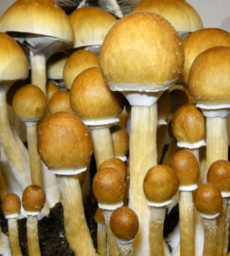
Huautla Oaxaca Spores
$19.98 – $217.50Huautla Oaxaca Spores
Huautla Oaxaca Spores mushrooms and their spores are also some of the most sought after psilocybe cubensis magic mushrooms ever found. Spores from the Huautla Oaxaca Spores mushroom are available here at SporeStore.com because you asked for them! Find both mushroom spore syringes and also mushroom spore prints. This psilocybe cubensis magic mushroom was first discovered on a farm NOT growing in a pile of dung and straw as its mushroom substrate in Mexico. There is no psilocybin or psilocin contained within magic mushroom spores, making them completely legal to purchase and posses in most jurisdictions throughout the USA. As well as make sure to check your local laws before ordering. The original Huautla Oaxaca Spores mushroom spores’ genetics from the true Huautla Oaxaca Spores psilocybe cubensis mushrooms from Mexico are brought to you by SporeStore.com, the leader in mushroom spores.
Spores from this strain are in abundance as it’s a healthy spore depositor.
Huautla Oaxaca Spores magic mushrooms are easy to grow. Check your local mushroom growing laws. Growing mushrooms for identification and taxonomy purposes? We have your spores!
In addition to the Huautla Oaxaca Spores spores, here are some other mushroom spores that you may be interested in reviewing: Alacabenzi mushroom magic spores, B+ mushroom spores which is also called B Plus mushroom spores, Malaysia Spores mushroom spores, PES Hawaiian mushroom spores, Ecuador spores
Furthermore check out our new Mushroom Grinder!
Mushroom Capsules found here…
More Detail:
Habitat: Bovine, Equine Dung and Enriched Soils
Climate: Subtropical
Strain Origin: Unknown
Cap: 50+ mm in diameter, convex to broadly convex to plane at maturity. Reddish cinnamon brown maturing to golden brown to light yellow because the surface is dry with pronounced and persistent remnants of universal veil on cap (spots) and the flesh is white soon bruising bluish green.
Stem: 125+ mm in length, yellowish. Flesh bruising bluish green where injured. Persistent membranous annulus (ring) from partial veil that becomes dusted with purple brown spores at maturity.
Gills: Attachment adnate to adnexed. Grayish coloration in young fruit bodies becoming nearly black in maturity.
Spores: Dark purplish brown, subellipsoid on 4-spored basidia
Storage: Store in a dark, cool and dry place and use within six months after delivery!
Taxonomy:
Kingdom: Fungi
Division: Basidiomycota
Class: Agaricomycetes
Order: Agaricales
Family: Strophariaceae
Genus: Psilocybe
Spores: purplish brown to dark brown, 11.5 – 17 x 8 – 11 µm, ellipsoidHabitat and distribution in nature:
Rye grain, wheat straw, horse or cow manure. This species can be found in the subtropical and tropical climate zones all around the globe under the following conditions: Spawn run incubation: 28 °C | Primordia formation: 23.3 – 25.6 °C | Fruiting: 23 – 26 °C
A 2011 study also found that more than a year after participants had a single psilocybin experience, their self-reported measures of openness remained significantly elevated, which researches in this study and beyond attribute to a somewhat mysterious but powerful aspect of a mushroom trip: the mystical experience.
In this case, a mystical experience is defined as “feelings of unity and interconnectedness with all people and things, a sense of sacredness, feelings of peace and joy, a sense of transcending normal time and space, ineffability, and an intuitive belief that the experience is a source of objective truth about the nature of reality.” The religious identification of people who have reported having a mystical-type experience during a mushroom trip span the spectrum, but interestingly the profundity of such experiences don’t seem to correlate to religious belief—even atheists have reported the importance of their psilocybin-induced mystical experiences. Additionally, research has shown that the more intense the mystical experience, the greater the positive, long-term changes a person sees.
These subjective effects, such as feelings of interconnectedness, are likely a result of psilocybin’s ability to decrease the interconnectivity of integration hubs in the brain. In plain speak, that means psilocybin allows for more “cross-talk” between regions of the brain that are typically segregated. Researchers speculate that this enables a state of “unconstrained cognition,” meaning the ways we typically organize, categorize, and differentiate the aspects of conscious experience are broken down, and thinking becomes more flexible. To understand how this might be beneficial, it helps to know that similar brain activity patterns are also observed during various states of meditation.
Habitat: Bovine, Equine Dung and Enriched Soils
Climate: Subtropical
Strain Origin: Oaxaca, Mexico
Cap: 25-50+ mm in diameter, convex to broadly convex to plane at maturity often with persistent acute umbo (nipple). Reddish cinnamon brown maturing to golden brown to light yellow with nearly white edges. Surface dry lacking remnants of universal veil on cap (spots). Flesh white soon bruising bluish green.
Stem: 150+ mm in length, yellowish. Flesh bruising bluish green where injured. Persistent membranous annulus (ring) from partial veil that becomes dusted with purple brown spores at maturity.
Gills: Attachment adnate to adnexed. Grayish coloration in young fruit bodies becoming nearly black in maturity.
Spores: Dark purplish brown, subellipsoid on 4-spored basidia
Habitat: Bovine, Equine Dung and Enriched Soils
Climate: Subtropical
Strain Origin:
This strain finds its origins in Huautla de Jímenez, a small village in the Oaxaca state of Mexico. This is the mushroom that Maria Sabina used for her veladas, when the Psilocybe caerulescens season was finished. It carries with it a spiritual load unequaled in Psilocybe cubensis. Interestingly Psilocybe cubensis Huautla was not seen growing directly on dung. -
Sale!
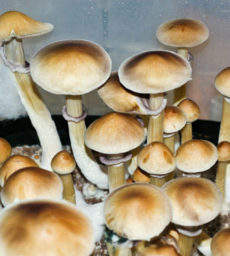
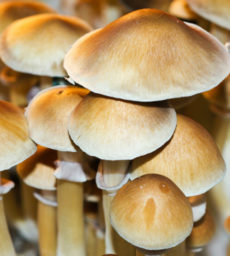
Burma Spores
$19.98 – $217.50Burma Spores
Burma Spores mushrooms and their spores are also some of the most sought after psilocybe cubensis magic mushrooms ever found. Spores from the Burma Spores mushroom are available here at SporeStore.com because you asked for them! Find both mushroom spore syringes and also mushroom spore prints. This psilocybe cubensis magic mushroom was first discovered on a farm growing in a pile of dung and straw as its mushroom substrate in Burma. There is no psilocybin or psilocin contained within magic mushroom spores, making them completely legal to purchase and posses in most jurisdictions throughout the USA. As well as make sure to check your local laws before ordering. The original Burma Spores mushroom spores’ genetics from the true Burma Spores psilocybe cubensis mushrooms from Burma are brought to you by SporeStore.com, the leader in mushroom spores.
Spores from this strain are in abundance as it’s a healthy spore depositor.
Burma Spores magic mushrooms are easy to grow. Check your local mushroom growing laws. Growing mushrooms for identification and taxonomy purposes? We have your spores!
In addition to the PES Amazonian Spores spores, here are some other mushroom spores that you may be interested in reviewing: Alacabenzi mushroom magic spores, B+ mushroom spores which is also called B Plus mushroom spores, Malaysia Spores mushroom spores, PES Hawaiian mushroom spores, Ecuador spores
Furthermore check out our new Mushroom Grinder!
Mushroom Capsules found here…
More Detail:
Habitat: Bovine, Equine Dung and Enriched Soils
Climate: Subtropical
Strain Origin: Burma (Myanmar)
Cap: 50+ mm in diameter, convex to broadly convex to plane at maturity. Reddish cinnamon brown maturing to golden brown to light yellow because the surface is dry with pronounced and persistent remnants of universal veil on cap (spots) and the flesh is white soon bruising bluish green.
Stem: 125+ mm in length, yellowish. Flesh bruising bluish green where injured. Persistent membranous annulus (ring) from partial veil that becomes dusted with purple brown spores at maturity.
Gills: Attachment adnate to adnexed. Grayish coloration in young fruit bodies becoming nearly black in maturity.
Spores: Dark purplish brown, subellipsoid on 4-spored basidia
Storage: Store in a dark, cool and dry place and use within six months after delivery!
Taxonomy:
Kingdom: Fungi
Division: Basidiomycota
Class: Agaricomycetes
Order: Agaricales
Family: Strophariaceae
Genus: Psilocybe
Spores: purplish brown to dark brown, 11.5 – 17 x 8 – 11 µm, ellipsoidHabitat and distribution in nature:
Rye grain, wheat straw, horse or cow manure. This species can be found in the subtropical and tropical climate zones all around the globe under the following conditions: Spawn run incubation: 28 °C | Primordia formation: 23.3 – 25.6 °C | Fruiting: 23 – 26 °C
A 2011 study also found that more than a year after participants had a single psilocybin experience, their self-reported measures of openness remained significantly elevated, which researches in this study and beyond attribute to a somewhat mysterious but powerful aspect of a mushroom trip: the mystical experience.
In this case, a mystical experience is defined as “feelings of unity and interconnectedness with all people and things, a sense of sacredness, feelings of peace and joy, a sense of transcending normal time and space, ineffability, and an intuitive belief that the experience is a source of objective truth about the nature of reality.” The religious identification of people who have reported having a mystical-type experience during a mushroom trip span the spectrum, but interestingly the profundity of such experiences don’t seem to correlate to religious belief—even atheists have reported the importance of their psilocybin-induced mystical experiences. Additionally, research has shown that the more intense the mystical experience, the greater the positive, long-term changes a person sees.
These subjective effects, such as feelings of interconnectedness, are likely a result of psilocybin’s ability to decrease the interconnectivity of integration hubs in the brain. In plain speak, that means psilocybin allows for more “cross-talk” between regions of the brain that are typically segregated. Researchers speculate that this enables a state of “unconstrained cognition,” meaning the ways we typically organize, categorize, and differentiate the aspects of conscious experience are broken down, and thinking becomes more flexible. To understand how this might be beneficial, it helps to know that similar brain activity patterns are also observed during various states of meditation.
Habitat: Bovine, Equine Dung and Enriched Soils
Climate: Subtropical
Strain Origin: Burma
Cap: 25-50+ mm in diameter, convex to broadly convex to plane at maturity often with persistent acute umbo (nipple). Reddish cinnamon brown maturing to golden brown to light yellow with nearly white edges. Surface dry lacking remnants of universal veil on cap (spots). Flesh white soon bruising bluish green.
Stem: 150+ mm in length, yellowish. Flesh bruising bluish green where injured. Persistent membranous annulus (ring) from partial veil that becomes dusted with purple brown spores at maturity.
Gills: Attachment adnate to adnexed. Grayish coloration in young fruit bodies becoming nearly black in maturity.
Spores: Dark purplish brown, subellipsoid on 4-spored basidia
Habitat: Bovine, Equine Dung and Enriched Soils
Climate: Subtropical
Strain Origin: Original specimen was collected from buffalo dung in an unplanted rice paddie outside the city of Yangoon, Burma. Original collection supplied via Mushroom John by way of a gift from a Thai student who spent time collecting mushroom samples around Yangoon (formaly Rangoon), Burma (now Myanmar)
Cap: 25-50+ mm in diameter, convex to broadly convex to plane at maturity. Reddish cinnamon brown maturing to golden brown to light yellow with nearly white edges. Surface dry lacking remnants of universal veil on cap (spots). Flesh white soon bruising bluish green.
Stem: 150+ mm in length, yellowish. Flesh bruising bluish green where injured. Persistent membranous annulus (ring) from partial veil that becomes dusted with purple brown spores at maturity.
Gills: Attachment adnate to adnexed. Grayish coloration in young fruit bodies becoming nearly black in maturity.
Spores: Dark purplish brown, subellipsoid on 4-spored basidia
-
Sale!
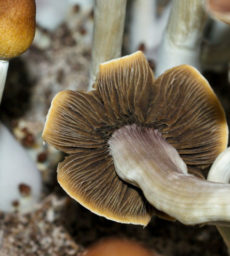
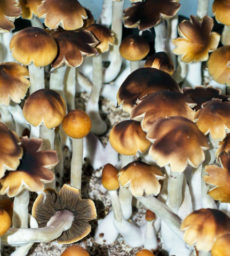
Puerto Rican Spores
$19.98 – $217.50Puerto Rican Spores
Puerto Rican Spores mushrooms and their spores are also some of the most sought after psilocybe cubensis magic mushrooms ever found. Spores from the Puerto Rican Spores mushroom are available here at SporeStore.com because you asked for them! Find both mushroom spore syringes and also mushroom spore prints. This psilocybe cubensis magic mushroom was first discovered on a farm growing in a pile of dung and straw as its mushroom substrate in Puerto Rico. There is no psilocybin or psilocin contained within magic mushroom spores, making them completely legal to purchase and posses in most jurisdictions throughout the USA. As well as make sure to check your local laws before ordering. The original Puerto Rican Spores mushroom spores’ genetics from the true Puerto Rican Spores psilocybe cubensis mushrooms from Puerto Rico are brought to you by SporeStore.com, the leader in mushroom spores.
Spores from this strain are in abundance as it’s a healthy spore depositor.
Puerto Rican Spores magic mushrooms are easy to grow. Check your local mushroom growing laws. Growing mushrooms for identification and taxonomy purposes? We have your spores!
In addition to the Puerto Rican Spores spores, here are some other mushroom spores that you may be interested in reviewing: Alacabenzi mushroom magic spores, B+ mushroom spores which is also called B Plus mushroom spores, Malaysia Spores mushroom spores, PES Hawaiian mushroom spores, Ecuador spores
Furthermore check out our new Mushroom Grinder!
Mushroom Capsules found here…
More Detail:
Habitat: Bovine, Equine Dung and Enriched Soils
Climate: Subtropical
Strain Origin: Puerto Rico
Cap: 50+ mm in diameter, convex to broadly convex to plane at maturity. Reddish cinnamon brown maturing to golden brown to light yellow because the surface is dry with pronounced and persistent remnants of universal veil on cap (spots) and the flesh is white soon bruising bluish green.
Stem: 125+ mm in length, yellowish. Flesh bruising bluish green where injured. Persistent membranous annulus (ring) from partial veil that becomes dusted with purple brown spores at maturity.
Gills: Attachment adnate to adnexed. Grayish coloration in young fruit bodies becoming nearly black in maturity.
Spores: Dark purplish brown, subellipsoid on 4-spored basidia
Storage: Store in a dark, cool and dry place and use within six months after delivery!
Taxonomy:
Kingdom: Fungi
Division: Basidiomycota
Class: Agaricomycetes
Order: Agaricales
Family: Strophariaceae
Genus: Psilocybe
Spores: purplish brown to dark brown, 11.5 – 17 x 8 – 11 µm, ellipsoidHabitat and distribution in nature:
Rye grain, wheat straw, horse or cow manure. This species can be found in the subtropical and tropical climate zones all around the globe under the following conditions: Spawn run incubation: 28 °C | Primordia formation: 23.3 – 25.6 °C | Fruiting: 23 – 26 °C
A 2011 study also found that more than a year after participants had a single psilocybin experience, their self-reported measures of openness remained significantly elevated, which researches in this study and beyond attribute to a somewhat mysterious but powerful aspect of a mushroom trip: the mystical experience.
In this case, a mystical experience is defined as “feelings of unity and interconnectedness with all people and things, a sense of sacredness, feelings of peace and joy, a sense of transcending normal time and space, ineffability, and an intuitive belief that the experience is a source of objective truth about the nature of reality.” The religious identification of people who have reported having a mystical-type experience during a mushroom trip span the spectrum, but interestingly the profundity of such experiences don’t seem to correlate to religious belief—even atheists have reported the importance of their psilocybin-induced mystical experiences. Additionally, research has shown that the more intense the mystical experience, the greater the positive, long-term changes a person sees.
These subjective effects, such as feelings of interconnectedness, are likely a result of psilocybin’s ability to decrease the interconnectivity of integration hubs in the brain. In plain speak, that means psilocybin allows for more “cross-talk” between regions of the brain that are typically segregated. Researchers speculate that this enables a state of “unconstrained cognition,” meaning the ways we typically organize, categorize, and differentiate the aspects of conscious experience are broken down, and thinking becomes more flexible. To understand how this might be beneficial, it helps to know that similar brain activity patterns are also observed during various states of meditation.
Habitat: Bovine, Equine Dung and Enriched Soils
Climate: Subtropical
Strain Origin: Puerto Rico
Cap: 25-50+ mm in diameter, convex to broadly convex to plane at maturity often with persistent acute umbo (nipple). Reddish cinnamon brown maturing to golden brown to light yellow with nearly white edges. Surface dry lacking remnants of universal veil on cap (spots). Flesh white soon bruising bluish green.
Stem: 150+ mm in length, yellowish. Flesh bruising bluish green where injured. Persistent membranous annulus (ring) from partial veil that becomes dusted with purple brown spores at maturity.
Gills: Attachment adnate to adnexed. Grayish coloration in young fruit bodies becoming nearly black in maturity.
Spores: Dark purplish brown, subellipsoid on 4-spored basidia
Habitat: Bovine, Equine Dung and Enriched Soils
Climate: Subtropical
Strain Origin: Puerto Rico, near the town of Canovanas located on the Northeast side of the island.
Cap: 50-75 mm in diameter, convex to broadly convex to nearly plane at maturity. Brown maturing to golden brown to light yellow. Surface dry with fine persistent remnants of universal veil on cap (spots). Flesh white soon bruising bluish green.
Stem: 125+ mm in length, yellowish. Flesh bruising bluish green where injured. Persistent membranous annulus (ring) from partial veil that becomes dusted with purple brown spores at maturity.
Gills: Attachment adnate to adnexed. Grayish coloration in young fruit bodies becoming nearly black in maturity.
Spores: Dark purplish brown, subellipsoid on 4-spored basidia
Form can be quite variable under laboratory conditions.
-
Sale!
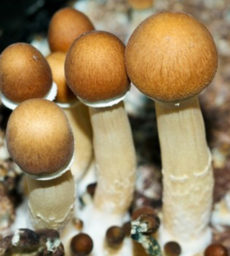
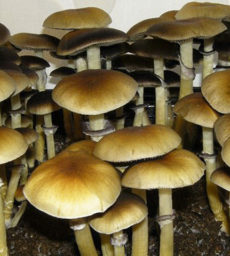
Mazatapec Spores
$19.98 – $217.50Mazatapec Spores
Mazatapec Spores mushrooms and their spores are also some of the most sought after psilocybe cubensis magic mushrooms ever found. Spores from the Mazatapec Spores mushroom are available here at SporeStore.com because you asked for them! Find both mushroom spore syringes and also mushroom spore prints. This psilocybe cubensis magic mushroom was first discovered on a farm growing in a pile of dung and straw as its mushroom substrate in Mexico. There is no psilocybin or psilocin contained within magic mushroom spores, making them completely legal to purchase and posses in most jurisdictions throughout the USA. As well as make sure to check your local laws before ordering. The original Mazatapec Spores mushroom spores’ genetics from the true Mazatapec Spores psilocybe cubensis mushrooms from Mexico are brought to you by SporeStore.com, the leader in mushroom spores.
Spores from this strain are in abundance as it’s a healthy spore depositor.
Mazatapec Spores magic mushrooms are easy to grow. Check your local mushroom growing laws. Growing mushrooms for identification and taxonomy purposes? We have your spores!
In addition to the PES Amazonian Spores spores, here are some other mushroom spores that you may be interested in reviewing: Alacabenzi mushroom magic spores, B+ mushroom spores which is also called B Plus mushroom spores, Malaysia Spores mushroom spores, PES Hawaiian mushroom spores, Ecuador spores
Furthermore check out our new Mushroom Grinder!
Mushroom Capsules found here…
More Detail:
Habitat: Bovine, Equine Dung and Enriched Soils
Climate: Subtropical
Strain Origin: Mexico
Cap: 50+ mm in diameter, convex to broadly convex to plane at maturity. Reddish cinnamon brown maturing to golden brown to light yellow because the surface is dry with pronounced and persistent remnants of universal veil on cap (spots) and the flesh is white soon bruising bluish green.
Stem: 125+ mm in length, yellowish. Flesh bruising bluish green where injured. Persistent membranous annulus (ring) from partial veil that becomes dusted with purple brown spores at maturity.
Gills: Attachment adnate to adnexed. Grayish coloration in young fruit bodies becoming nearly black in maturity.
Spores: Dark purplish brown, subellipsoid on 4-spored basidia
Storage: Store in a dark, cool and dry place and use within six months after delivery!
Taxonomy:
Kingdom: Fungi
Division: Basidiomycota
Class: Agaricomycetes
Order: Agaricales
Family: Strophariaceae
Genus: Psilocybe
Spores: purplish brown to dark brown, 11.5 – 17 x 8 – 11 µm, ellipsoidHabitat and distribution in nature:
Rye grain, wheat straw, horse or cow manure. This species can be found in the subtropical and tropical climate zones all around the globe under the following conditions: Spawn run incubation: 28 °C | Primordia formation: 23.3 – 25.6 °C | Fruiting: 23 – 26 °C
A 2011 study also found that more than a year after participants had a single psilocybin experience, their self-reported measures of openness remained significantly elevated, which researches in this study and beyond attribute to a somewhat mysterious but powerful aspect of a mushroom trip: the mystical experience.
In this case, a mystical experience is defined as “feelings of unity and interconnectedness with all people and things, a sense of sacredness, feelings of peace and joy, a sense of transcending normal time and space, ineffability, and an intuitive belief that the experience is a source of objective truth about the nature of reality.” The religious identification of people who have reported having a mystical-type experience during a mushroom trip span the spectrum, but interestingly the profundity of such experiences don’t seem to correlate to religious belief—even atheists have reported the importance of their psilocybin-induced mystical experiences. Additionally, research has shown that the more intense the mystical experience, the greater the positive, long-term changes a person sees.
These subjective effects, such as feelings of interconnectedness, are likely a result of psilocybin’s ability to decrease the interconnectivity of integration hubs in the brain. In plain speak, that means psilocybin allows for more “cross-talk” between regions of the brain that are typically segregated. Researchers speculate that this enables a state of “unconstrained cognition,” meaning the ways we typically organize, categorize, and differentiate the aspects of conscious experience are broken down, and thinking becomes more flexible. To understand how this might be beneficial, it helps to know that similar brain activity patterns are also observed during various states of meditation.
Habitat: Bovine, Equine Dung and Enriched Soils
Climate: Subtropical
Strain Origin: Mexico
Cap: 25-50+ mm in diameter, convex to broadly convex to plane at maturity often with persistent acute umbo (nipple). Reddish cinnamon brown maturing to golden brown to light yellow with nearly white edges. Surface dry lacking remnants of universal veil on cap (spots). Flesh white soon bruising bluish green.
Stem: 150+ mm in length, yellowish. Flesh bruising bluish green where injured. Persistent membranous annulus (ring) from partial veil that becomes dusted with purple brown spores at maturity.
Gills: Attachment adnate to adnexed. Grayish coloration in young fruit bodies becoming nearly black in maturity.
Spores: Dark purplish brown, subellipsoid on 4-spored basidia
Habitat: Bovine, Equine Dung and Enriched Soils
Climate: Subtropical
Strain Origin: Mexico
Cap: 50+ mm in diameter, convex to broadly convex at maturity occasionally with acute umbo. Dark cinnamon brown maturing to golden brown. Surface dry lacking remnants of universal veil on cap (spots). Flesh white soon bruising bluish green.
Stem: 75-125 mm in length, yellowish to buff. Flesh bruising bluish green where injured. Persistent membranous annulus (ring) from partial veil that becomes dusted with purple brown spores at maturity.
Gills: Attachment adnate to adnexed. Grayish coloration in young fruit bodies becoming nearly black in maturity.
Spores: Dark purplish brown, subellipsoid on 4-spored basidia
-
Sale!
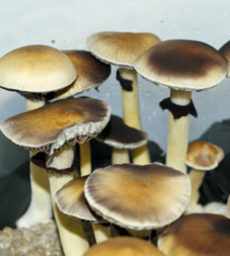
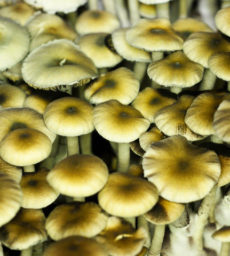
Nepal Chitwan Spores
$19.98 – $217.50Nepal Chitwan Spores
Nepal Chitwan Spores mushrooms and their spores are also some of the most sought after psilocybe cubensis magic mushrooms ever found. Spores from the Nepal Chitwan Spores mushroom are available here at SporeStore.com because you asked for them! Find both mushroom spore syringes and also mushroom spore prints. This psilocybe cubensis magic mushroom was first discovered on a farm growing in a pile of dung and straw as its mushroom substrate in Nepal. There is no psilocybin or psilocin contained within magic mushroom spores, making them completely legal to purchase and posses in most jurisdictions throughout the USA. As well as make sure to check your local laws before ordering. The original Nepal Chitwan Spores mushroom spores’ genetics from the true Nepal Chitwan Spores psilocybe cubensis mushrooms from Nepal are brought to you by SporeStore.com, the leader in mushroom spores.
Spores from this strain are in abundance as it’s a healthy spore depositor.
Nepal Chitwan Spores magic mushrooms are easy to grow. Check your local mushroom growing laws. Growing mushrooms for identification and taxonomy purposes? We have your spores!
In addition to the Nepal Chitwan Spores spores, here are some other mushroom spores that you may be interested in reviewing: Alacabenzi mushroom magic spores, B+ mushroom spores which is also called B Plus mushroom spores, Malaysia Spores mushroom spores, PES Hawaiian mushroom spores, Ecuador spores
Furthermore check out our new Mushroom Grinder!
Mushroom Capsules found here…
More Detail:
Habitat: Bovine, Equine Dung and Enriched Soils
Climate: Subtropical
Strain Origin: Nepal
Cap: 50+ mm in diameter, convex to broadly convex to plane at maturity. Reddish cinnamon brown maturing to golden brown to light yellow because the surface is dry with pronounced and persistent remnants of universal veil on cap (spots) and the flesh is white soon bruising bluish green.
Stem: 125+ mm in length, yellowish. Flesh bruising bluish green where injured. Persistent membranous annulus (ring) from partial veil that becomes dusted with purple brown spores at maturity.
Gills: Attachment adnate to adnexed. Grayish coloration in young fruit bodies becoming nearly black in maturity.
Spores: Dark purplish brown, subellipsoid on 4-spored basidia
Storage: Store in a dark, cool and dry place and use within six months after delivery!
Taxonomy:
Kingdom: Fungi
Division: Basidiomycota
Class: Agaricomycetes
Order: Agaricales
Family: Strophariaceae
Genus: Psilocybe
Spores: purplish brown to dark brown, 11.5 – 17 x 8 – 11 µm, ellipsoidHabitat and distribution in nature:
Rye grain, wheat straw, horse or cow manure. This species can be found in the subtropical and tropical climate zones all around the globe under the following conditions: Spawn run incubation: 28 °C | Primordia formation: 23.3 – 25.6 °C | Fruiting: 23 – 26 °C
A 2011 study also found that more than a year after participants had a single psilocybin experience, their self-reported measures of openness remained significantly elevated, which researches in this study and beyond attribute to a somewhat mysterious but powerful aspect of a mushroom trip: the mystical experience.
In this case, a mystical experience is defined as “feelings of unity and interconnectedness with all people and things, a sense of sacredness, feelings of peace and joy, a sense of transcending normal time and space, ineffability, and an intuitive belief that the experience is a source of objective truth about the nature of reality.” The religious identification of people who have reported having a mystical-type experience during a mushroom trip span the spectrum, but interestingly the profundity of such experiences don’t seem to correlate to religious belief—even atheists have reported the importance of their psilocybin-induced mystical experiences. Additionally, research has shown that the more intense the mystical experience, the greater the positive, long-term changes a person sees.
These subjective effects, such as feelings of interconnectedness, are likely a result of psilocybin’s ability to decrease the interconnectivity of integration hubs in the brain. In plain speak, that means psilocybin allows for more “cross-talk” between regions of the brain that are typically segregated. Researchers speculate that this enables a state of “unconstrained cognition,” meaning the ways we typically organize, categorize, and differentiate the aspects of conscious experience are broken down, and thinking becomes more flexible. To understand how this might be beneficial, it helps to know that similar brain activity patterns are also observed during various states of meditation.
Habitat: Bovine, Equine Dung and Enriched Soils
Climate: Subtropical
Strain Origin: Nepal
Cap: 25-50+ mm in diameter, convex to broadly convex to plane at maturity often with persistent acute umbo (nipple). Reddish cinnamon brown maturing to golden brown to light yellow with nearly white edges. Surface dry lacking remnants of universal veil on cap (spots). Flesh white soon bruising bluish green.
Stem: 150+ mm in length, yellowish. Flesh bruising bluish green where injured. Persistent membranous annulus (ring) from partial veil that becomes dusted with purple brown spores at maturity.
Gills: Attachment adnate to adnexed. Grayish coloration in young fruit bodies becoming nearly black in maturity.
Spores: Dark purplish brown, subellipsoid on 4-spored basidia
Habitat: Bovine, Equine Dung and Enriched Soils
Climate: Subtropical
Strain Origin: Nepal, Chitwan. Original collection material was obtained by Baerbel in the village of Sauraha near the Chitwan Jungle of Nepal. Three specimens were located in otherwise dry climate conditions (three months after typical mushroom seasons), and shaded by a nearby tree. Specimens picked from what appeared to be either elephant or rhino dung. Original sample specimen pictures below and right.
Cap: 20-70 mm in diameter, hemispheric expanding to nearly plane with age. Golden brown maturing to light brown. Fine fibrillose veil remnants when young that soon mostly disappear. Flesh yellowish white soon bruising bluish green.
Stem: 150-200+ mm in length. Typically equal, sometimes slightly enlarged at base. Yellowish to buff with a reflective sheen, bruising bluish, semi hollow with remains of the partial veil.
Gills: Attachment adnate to adnexed. Yellowish coloration in young fruit bodies becoming darker in maturity. Remains of the partial veil attached at the outer circumference of the cap.
Spores: Dark purplish brown, subellipsoid on 4-spored basidia
-
Sale!
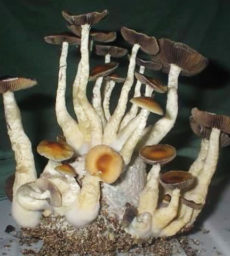
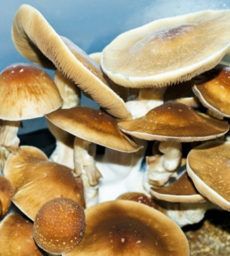
PF Classic Professor Fanaticus Spores
$19.98 – $217.50PF Classic Professor Fanaticus Spores
PF Classic Professor Fanaticus Spores mushrooms and their spores are also some of the most sought after psilocybe cubensis magic mushrooms ever found. Spores from the PF Classic Professor Fanaticus Spores mushroom are available here at SporeStore.com because you asked for them! Find both mushroom spore syringes and also mushroom spore prints. This psilocybe cubensis magic mushroom was first discovered on a farm growing in a pile of dung and straw as its mushroom substrate in Florida. There is no psilocybin or psilocin contained within magic mushroom spores, making them completely legal to purchase and posses in most jurisdictions throughout the USA. As well as make sure to check your local laws before ordering. The original PF Classic Professor Fanaticus Spores mushroom spores’ genetics from the true PF Classic Professor Fanaticus Spores psilocybe cubensis mushrooms from Florida are brought to you by SporeStore.com, the leader in mushroom spores.
Spores from this strain are in abundance as it’s a healthy spore depositor.
PF Classic Professor Fanaticus Spores magic mushrooms are easy to grow. Check your local mushroom growing laws. Growing mushrooms for identification and taxonomy purposes? We have your spores!
In addition to the PF Classic Professor Fanaticus Spores spores, here are some other mushroom spores that you may be interested in reviewing: Alacabenzi mushroom magic spores, B+ mushroom spores which is also called B Plus mushroom spores, Malaysia Spores mushroom spores, PES Hawaiian mushroom spores, Ecuador spores
Furthermore check out our new Mushroom Grinder!
Mushroom Capsules found here…
More Detail:
Habitat: Bovine, Equine Dung and Enriched Soils
Climate: Subtropical
Strain Origin: Florida
Cap: 50+ mm in diameter, convex to broadly convex to plane at maturity. Reddish cinnamon brown maturing to golden brown to light yellow because the surface is dry with pronounced and persistent remnants of universal veil on cap (spots) and the flesh is white soon bruising bluish green.
Stem: 125+ mm in length, yellowish. Flesh bruising bluish green where injured. Persistent membranous annulus (ring) from partial veil that becomes dusted with purple brown spores at maturity.
Gills: Attachment adnate to adnexed. Grayish coloration in young fruit bodies becoming nearly black in maturity.
Spores: Dark purplish brown, subellipsoid on 4-spored basidia
Storage: Store in a dark, cool and dry place and use within six months after delivery!
Taxonomy:
Kingdom: Fungi
Division: Basidiomycota
Class: Agaricomycetes
Order: Agaricales
Family: Strophariaceae
Genus: Psilocybe
Spores: purplish brown to dark brown, 11.5 – 17 x 8 – 11 µm, ellipsoidHabitat and distribution in nature:
Rye grain, wheat straw, horse or cow manure. This species can be found in the subtropical and tropical climate zones all around the globe under the following conditions: Spawn run incubation: 28 °C | Primordia formation: 23.3 – 25.6 °C | Fruiting: 23 – 26 °C
A 2011 study also found that more than a year after participants had a single psilocybin experience, their self-reported measures of openness remained significantly elevated, which researches in this study and beyond attribute to a somewhat mysterious but powerful aspect of a mushroom trip: the mystical experience.
In this case, a mystical experience is defined as “feelings of unity and interconnectedness with all people and things, a sense of sacredness, feelings of peace and joy, a sense of transcending normal time and space, ineffability, and an intuitive belief that the experience is a source of objective truth about the nature of reality.” The religious identification of people who have reported having a mystical-type experience during a mushroom trip span the spectrum, but interestingly the profundity of such experiences don’t seem to correlate to religious belief—even atheists have reported the importance of their psilocybin-induced mystical experiences. Additionally, research has shown that the more intense the mystical experience, the greater the positive, long-term changes a person sees.
These subjective effects, such as feelings of interconnectedness, are likely a result of psilocybin’s ability to decrease the interconnectivity of integration hubs in the brain. In plain speak, that means psilocybin allows for more “cross-talk” between regions of the brain that are typically segregated. Researchers speculate that this enables a state of “unconstrained cognition,” meaning the ways we typically organize, categorize, and differentiate the aspects of conscious experience are broken down, and thinking becomes more flexible. To understand how this might be beneficial, it helps to know that similar brain activity patterns are also observed during various states of meditation.
Habitat: Bovine, Equine Dung and Enriched Soils
Climate: Subtropical
Strain Origin: Florida
Cap: 25-50+ mm in diameter, convex to broadly convex to plane at maturity often with persistent acute umbo (nipple). Reddish cinnamon brown maturing to golden brown to light yellow with nearly white edges. Surface dry lacking remnants of universal veil on cap (spots). Flesh white soon bruising bluish green.
Stem: 150+ mm in length, yellowish. Flesh bruising bluish green where injured. Persistent membranous annulus (ring) from partial veil that becomes dusted with purple brown spores at maturity.
Gills: Attachment adnate to adnexed. Grayish coloration in young fruit bodies becoming nearly black in maturity.
Spores: Dark purplish brown, subellipsoid on 4-spored basidia
P.F. stands for Psilocybe Fanaticus also known as Professor Fanaticus, a legendary mycologist that revolutionized the industry and isolated this sub-strain.
1. CAP (size – shape stages – colors)
The primordia start dark reddish. The cap is a fairly dark reddish (deep colors) and thick. It starts dome like and goes to plane at maturity and continues to grow until it is upturned and convoluted, with the gills a very deep brown, with streaks of purple (spore deposits) across and around the cap.2. STEM (length – girth – flesh – colors)
It can be short and fat or long and hefty. It depends on the air and humidity. The PF race responds to this seriously. with lots of air and humidity, the PF stem is long, slender, thick fleshed and white. The flesh of the PF race is unique amongst all the races. It is very much like soft moist BREAD. But sometimes there can be a bit of fibrousness here and there.3. VEIL (deliquescent – partly deliquescent – persistant anulus)
The PF race has a definitely deliquescent veil. When the veil breaks during growth of the shroom, it usually breaks off from the stem and breaks up around the gills, leaving veil remnants all over the gills and mainly on the edges. But, sometimes there is a veil that becomes like an anulus (around the stem) but at close inspection, the veil will not be attached securely and usually might just hang in part. Also, there is serious differences amongst the races at how the gills attach to the stem under the cap. The PF gills attach closely. Whereas the Malaysian gills have a rather large gap where the gills attach to the underside of the cap. Gill stem and cap attachment is a definite trait of races, but unfortuneatly, further observations and notes are required for any in depth descriptions. But note that all these races have distinct gill attachment traits that adds to the differences!4. SPORULATION (at what developement stage does it begin?)
The PF race is a slow maturing shroom. It can grow large and the cap expand, but the gills will still be biege or light colored. Then, after about a day or two, the purple deposits of the spores will appear on the stem, and the gills will be darker brown. But sometimes, sterile specimens will appear. These are shrooms that don’t develope spores and the gills remain distinctly light colored (biege – tan – yellowish). They have no spores. I once knew someone who cloned this type of sterile strain and claimed it to be the best in potency, overall. This fits with the observation that potency diminishes as sporulation developes. So without sporulation ever starting, the potency doesn’t diminish in relation.5. TENACIOUSNES (Strength of attachment of the stem base to the cake)
The PF is the champ at this. Usually the PF shroom as a large base (big foot). In fact, “BIG FOOT” should be the sur name of the PF race. This makes the PF race the most tenacious to the substrate of them all. When harvested, it is common to pull off large chunks of cake in the process.6. SHAPE SHIFTING (shapes and changes of flush to flush – strain to strain)
The PF race is the champ in this also. It goes from ugly little abhorts and convoluted dwarfs, to tall robust white thick stemed specimens with large deep reddish colored caps that go to plane and then wildly upturn at full maturity.7. SIZE TENDANCIES (overall size of the mushroom at maturity)
Small to about as big as they get.8. GESTATION PERIOD (generalized time of primordia appearance after inoculation)
The PF might be the champ here also. It is the first of any of these shrooms observed to form primordia invitro. The others can, but the PF is a speed demon in comparison. And the PF invitro primordiation is far more numerous if allowed to develope and not birth so quick. But also, many if not most of the primordia will abort. The PF shroom is the champ at aborting shrooms also. That is why it has such a love hate relationship with the hobbiests.9. POTENCY (This simply comes down to how fast the shroom loses its latent potency – relating to the advent of sporulation)
The PF potency gets a big thumbs up from everywhere. Its advantage is that is a slow maturer, so it gives a wider envelope for the shroom to be harvested in its peak potency. A lot of hobbiests rate the PF race number one in potency. But that is not written in stone.10. FLUSHING (Ability to repeat flush)
The PF race usually flushes rather poorly on the first flush, giving mostly abhorts. And it can flush nicely the first time. But with a recasing treament. the second flush will be totally different and be excellent. The third flush is always decent and one can squeeze the lemon for nice looking healthy third flush stragglers. But all in all, it is good for three interesting flushes, PF style. -
Sale!
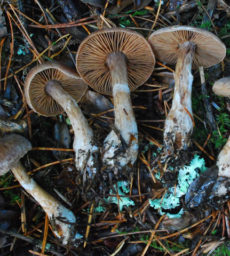
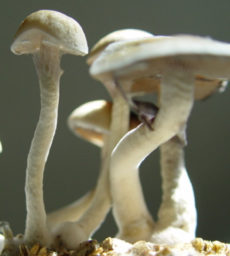
Hanoi Spores
$19.98 – $217.50Hanoi Spores
Hanoi Spores mushrooms and their spores are also some of the most sought after psilocybe cubensis magic mushrooms ever found. Spores from the Hanoi Spores mushroom are available here at SporeStore.com because you asked for them! Find both mushroom spore syringe and also mushroom spore prints. This psilocybe cubensis magic mushroom was first discovered on a small rural farm in Vietnam growing in a pile of dung and straw as its mushroom substrate outside the Vietnamese city of Hanoi. There is no psilocybin or psilocin contained within magic mushroom spores, making them completely legal to purchase and posses in most jurisdictions throughout the USA. As well as make sure to check your local laws before ordering. The original Hanoi Spores mushroom spores’ genetics from the true Hanoi Spores psilocybe cubensis mushrooms originally from Vietnam are brought to you by SporeStore.com, the leader in mushroom spores.
Spores from this strain are in abundance as it’s a healthy spore depositor.
Hanoi Spores magic mushrooms are easy to grow. Check your local mushroom growing laws. Growing mushrooms for identification and taxonomy purposes? We have your spores!
In addition to the Hanoi Spores spores, here are some other mushroom spores that you may be interested in reviewing: Alcabenzi mushroom magic spores, B+ mushroom spores which is also called B Plus mushroom spores, PES Amazonian mushroom spores, PES Hawaiian mushroom spores, Ecuador spores
Furthermore check out our new Mushroom Grinder!
Mushroom Capsules found here…
More Detail:
Habitat: Bovine, Equine Dung and Enriched Soils
Climate: Subtropical
Strain Origin: Unknown
Cap: 50+ mm in diameter, convex to broadly convex to plane at maturity. Reddish cinnamon brown maturing to golden brown to light yellow because the surface is dry with pronounced and persistent remnants of universal veil on cap (spots) and the flesh is white soon bruising bluish green.
Stem: 120+ mm in length, yellowish. Flesh bruising bluish green where injured. Persistent membranous annulus (ring) from partial veil that becomes dusted with purple brown spores at maturity.
Gills: Attachment adnate to adnexed. Grayish coloration in young fruit bodies becoming nearly black in maturity.
Spores: Dark purplish brown, subellipsoid on 4-spored basidia
Storage: Store in a dark, cool and dry place and use within six months after delivery!
Taxonomy:
Kingdom: Fungi
Division: Basidiomycota
Class: Agaricomycetes
Order: Agaricales
Family: Strophariaceae
Genus: Psilocybe
Spores: purplish brown to dark brown, 11.5 – 17 x 8 – 11 µm, ellipsoidHabitat and distribution in nature:
Rye grain, wheat straw, horse or cow manure. This species can be found in the subtropical and tropical climate zones all around the globe under the following conditions: Spawn run: 28 °C | Primordia formation: 23.3 – 25.6 °C | Fruiting: 23 – 26 °C
This substrain of Vietnam is a great addition to any spore collection.
In the wild these mushrooms are extremely rhizomorphic with an excellent pinset. If you like the Vietnam or Ban Hua Thanon then give this one a look under your microscope.
-
Sale!
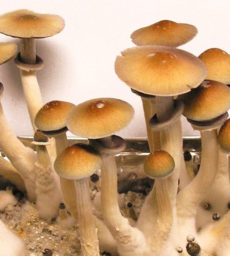
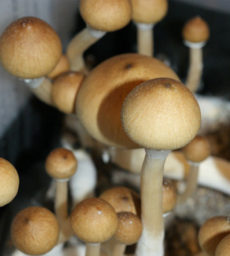
PES Hawaiian Spores
$19.98 – $217.50PES Hawaiian Spores
PES Hawaiian Spores mushrooms and their spores are also some of the most sought after psilocybe cubensis magic mushrooms ever found. Spores from the PES Hawaiian Spores mushroom are available here at SporeStore.com because you asked for them! Find both mushroom spore syringes and also mushroom spore prints. This psilocybe cubensis magic mushroom was first discovered on a farm growing in a pile of dung and straw as its mushroom substrate in Hawaii. There is no psilocybin or psilocin contained within magic mushroom spores, making them completely legal to purchase and posses in most jurisdictions throughout the USA. As well as make sure to check your local laws before ordering. The original PES Hawaiian Spores mushroom spores’ genetics from the true PES Hawaiian Spores psilocybe cubensis mushrooms from Hawaii are brought to you by SporeStore.com, the leader in mushroom spores.
Spores from this strain are in abundance as it’s a healthy spore depositor.
PES Hawaiian Spores magic mushrooms are easy to grow. Check your local mushroom growing laws. Growing mushrooms for identification and taxonomy purposes? We have your spores!
In addition to the PES Hawaiian Spores spores, here are some other mushroom spores that you may be interested in reviewing: Alcabenzi mushroom magic spores, B+ mushroom spores which is also called B Plus mushroom spores, PES Amazonian mushroom spores, Malaysia mushroom spores, Ecuador spores
Furthermore check out our new Mushroom Grinder!
Mushroom Capsules found here…
More Detail:
Habitat: Bovine, Equine Dung and Enriched Soils
Climate: Tropical
Strain Origin: Unknown
Cap: 50+ mm in diameter, convex to broadly convex to plane at maturity. Reddish cinnamon brown maturing to golden brown to light yellow because the surface is dry with pronounced and persistent remnants of universal veil on cap (spots) and the flesh is white soon bruising bluish green.
Stem: 125+ mm in length, yellowish. Flesh bruising bluish green where injured. Persistent membranous annulus (ring) from partial veil that becomes dusted with purple brown spores at maturity.
Gills: Attachment adnate to adnexed. Grayish coloration in young fruit bodies becoming nearly black in maturity.
Spores: Dark purplish brown, subellipsoid on 4-spored basidia
Storage: Store in a dark, cool and dry place and use within six months after delivery!
Taxonomy:
Kingdom: Fungi
Division: Basidiomycota
Class: Agaricomycetes
Order: Agaricales
Family: Strophariaceae
Genus: Psilocybe
Spores: purplish brown to dark brown, 11.5 – 17 x 8 – 11 µm, ellipsoidHabitat and distribution in nature:
Rye grain, wheat straw, horse or cow manure. This species can be found in the subtropical and tropical climate zones all around the globe under the following conditions: Spawn run incubation: 28 °C | Primordia formation: 23.3 – 25.6 °C | Fruiting: 23 – 26 °C
A 2011 study also found that more than a year after participants had a single psilocybin experience, their self-reported measures of openness remained significantly elevated, which researches in this study and beyond attribute to a somewhat mysterious but powerful aspect of a mushroom trip: the mystical experience.
In this case, a mystical experience is defined as “feelings of unity and interconnectedness with all people and things, a sense of sacredness, feelings of peace and joy, a sense of transcending normal time and space, ineffability, and an intuitive belief that the experience is a source of objective truth about the nature of reality.” The religious identification of people who have reported having a mystical-type experience during a mushroom trip span the spectrum, but interestingly the profundity of such experiences don’t seem to correlate to religious belief—even atheists have reported the importance of their psilocybin-induced mystical experiences. Additionally, research has shown that the more intense the mystical experience, the greater the positive, long-term changes a person sees.
These subjective effects, such as feelings of interconnectedness, are likely a result of psilocybin’s ability to decrease the interconnectivity of integration hubs in the brain. In plain speak, that means psilocybin allows for more “cross-talk” between regions of the brain that are typically segregated. Researchers speculate that this enables a state of “unconstrained cognition,” meaning the ways we typically organize, categorize, and differentiate the aspects of conscious experience are broken down, and thinking becomes more flexible. To understand how this might be beneficial, it helps to know that similar brain activity patterns are also observed during various states of meditation.
Habitat: Bovine, Equine Dung and Enriched Soils
Climate: Subtropical
Strain Origin: Unknown, Psilocybe cubensis is not documented to be present in Hawaii. PES stock (Pacific Exotica Spora)
Cap: 25-75 mm in diameter, convex to broadly convex to plane at maturity. Reddish cinnamon brown maturing to golden brown to light yellow. Surface dry with often-persistent remnants of universal veil on cap (spots). Flesh white soon bruising bluish green.
Stem: 125-175 mm in length, yellowish. Flesh bruising bluish green where injured. Persistent membranous annulus (ring) from partial veil that becomes dusted with purple brown spores at maturity.
Gills: Attachment adnate to adnexed. Grayish coloration in young fruit bodies becoming nearly black in maturity.
Spores: Dark purplish brown, subellipsoid on 4-spored basidia
-
Sale!
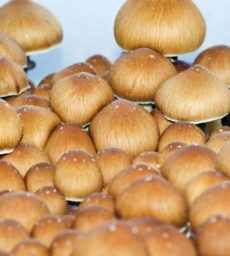
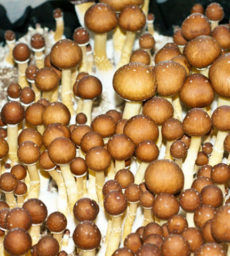
Golden Teacher Spores
$19.98 – $217.50Golden Teacher Spores
Golden Teacher Spores mushrooms and their spores are also some of the most sought after psilocybe cubensis magic mushrooms ever found. Spores from the Golden Teacher Spores mushroom are available here at SporeStore.com because you asked for them! Find both mushroom spore syringes and also mushroom spore prints. This psilocybe cubensis magic mushroom was first discovered on a farm growing in a pile of dung and straw as its mushroom substrate in Georgia. There is no psilocybin or psilocin contained within magic mushroom spores, making them completely legal to purchase and posses in most jurisdictions throughout the USA. As well as make sure to check your local laws before ordering. The original Golden Teacher Spores mushroom spores’ genetics from the true Golden Teachers Shrooms psilocybe cubensis mushrooms from Georgia are brought to you by SporeStore.com, the leader in mushroom spores.
Spores from this strain are in abundance as it’s a healthy spore depositor.
Golden Teacher Spores magic mushrooms are easy to grow. Check your local mushroom growing laws. Growing mushrooms for identification and taxonomy purposes? We have your spores!
In addition to the Golden Teacher Spores spores, here are some other mushroom spores that you may be interested in reviewing: Alcabenzi mushroom magic spores, B+ mushroom spores which is also called B Plus mushroom spores, PES Amazonian mushroom spores, PES Hawaiian mushroom spores, Ecuador spores
Furthermore check out our new Mushroom Grinder!
Mushroom Capsules found here…
More Detail:
Habitat: Bovine, Equine Dung and Enriched Soils
Climate: Subtropical
Strain Origin: Unknown
Cap: 50+ mm in diameter, convex to broadly convex to plane at maturity. Reddish cinnamon brown maturing to golden brown to light yellow because the surface is dry with pronounced and persistent remnants of universal veil on cap (spots) and the flesh is white soon bruising bluish green.
Stem: 125+ mm in length, yellowish. Flesh bruising bluish green where injured. Persistent membranous annulus (ring) from partial veil that becomes dusted with purple brown spores at maturity.
Gills: Attachment adnate to adnexed. Grayish coloration in young fruit bodies becoming nearly black in maturity.
Spores: Dark purplish brown, subellipsoid on 4-spored basidia
Storage: Store in a dark, cool and dry place and use within six months after delivery!
Taxonomy:
Kingdom: Fungi
Division: Basidiomycota
Class: Agaricomycetes
Order: Agaricales
Family: Strophariaceae
Genus: Psilocybe
Spores: purplish brown to dark brown, 11.5 – 17 x 8 – 11 µm, ellipsoidHabitat and distribution in nature:
Rye grain, wheat straw, horse or cow manure. This species can be found in the subtropical and tropical climate zones all around the globe under the following conditions: Spawn run incubation: 28 °C | Primordia formation: 23.3 – 25.6 °C | Fruiting: 23 – 26 °C
A 2011 study also found that more than a year after participants had a single psilocybin experience, their self-reported measures of openness remained significantly elevated, which researches in this study and beyond attribute to a somewhat mysterious but powerful aspect of a mushroom trip: the mystical experience.
In this case, a mystical experience is defined as “feelings of unity and interconnectedness with all people and things, a sense of sacredness, feelings of peace and joy, a sense of transcending normal time and space, ineffability, and an intuitive belief that the experience is a source of objective truth about the nature of reality.” The religious identification of people who have reported having a mystical-type experience during a mushroom trip span the spectrum, but interestingly the profundity of such experiences don’t seem to correlate to religious belief—even atheists have reported the importance of their psilocybin-induced mystical experiences. Additionally, research has shown that the more intense the mystical experience, the greater the positive, long-term changes a person sees.
These subjective effects, such as feelings of interconnectedness, are likely a result of psilocybin’s ability to decrease the interconnectivity of integration hubs in the brain. In plain speak, that means psilocybin allows for more “cross-talk” between regions of the brain that are typically segregated. Researchers speculate that this enables a state of “unconstrained cognition,” meaning the ways we typically organize, categorize, and differentiate the aspects of conscious experience are broken down, and thinking becomes more flexible. To understand how this might be beneficial, it helps to know that similar brain activity patterns are also observed during various states of meditation.
-
Sale!
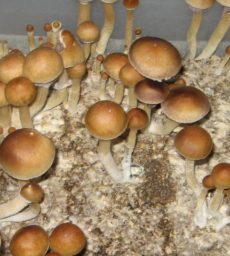
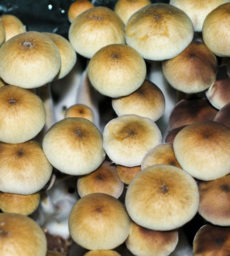
Treasure Coast Spores
$19.98 – $217.50Treasure Coast Spores
Treasure Coast Spores mushrooms and their spores are also some of the most sought after psilocybe cubensis magic mushrooms ever found. Spores from the Treasure Coast Spores mushroom are available here at SporeStore.com because you asked for them! Find both mushroom spore syringes and also mushroom spore prints. This psilocybe cubensis magic mushroom was first discovered on a farm growing in a pile of dung and straw as its mushroom substrate in Florida. There is no psilocybin or psilocin contained within magic mushroom spores, making them completely legal to purchase and posses in most jurisdictions throughout the USA. As well as make sure to check your local laws before ordering. The original Treasure Coast Spores mushroom spores’ genetics from the true Treasure Coast Spores psilocybe cubensis mushrooms from Florida are brought to you by SporeStore.com, the leader in mushroom spores.
Spores from this strain are in abundance as it’s a healthy spore depositor.
Treasure Coast Spores magic mushrooms are easy to grow. Check your local mushroom growing laws. Growing mushrooms for identification and taxonomy purposes? We have your spores!
In addition to the Treasure Coast Spores spores, here are some other mushroom spores that you may be interested in reviewing: Alacabenzi mushroom magic spores, B+ mushroom spores which is also called B Plus mushroom spores, Malaysia Spores mushroom spores, PES Hawaiian mushroom spores, Ecuador spores
Furthermore check out our new Mushroom Grinder!
Mushroom Capsules found here…
More Detail:
Habitat: Bovine, Equine Dung and Enriched Soils
Climate: Subtropical
Strain Origin: Unknown
Cap: 50+ mm in diameter, convex to broadly convex to plane at maturity. Reddish cinnamon brown maturing to golden brown to light yellow because the surface is dry with pronounced and persistent remnants of universal veil on cap (spots) and the flesh is white soon bruising bluish green.
Stem: 125+ mm in length, yellowish. Flesh bruising bluish green where injured. Persistent membranous annulus (ring) from partial veil that becomes dusted with purple brown spores at maturity.
Gills: Attachment adnate to adnexed. Grayish coloration in young fruit bodies becoming nearly black in maturity.
Spores: Dark purplish brown, subellipsoid on 4-spored basidia
Storage: Store in a dark, cool and dry place and use within six months after delivery!
Taxonomy:
Kingdom: Fungi
Division: Basidiomycota
Class: Agaricomycetes
Order: Agaricales
Family: Strophariaceae
Genus: Psilocybe
Spores: purplish brown to dark brown, 11.5 – 17 x 8 – 11 µm, ellipsoidHabitat and distribution in nature:
Rye grain, wheat straw, horse or cow manure. This species can be found in the subtropical and tropical climate zones all around the globe under the following conditions: Spawn run incubation: 28 °C | Primordia formation: 23.3 – 25.6 °C | Fruiting: 23 – 26 °C
A 2011 study also found that more than a year after participants had a single psilocybin experience, their self-reported measures of openness remained significantly elevated, which researches in this study and beyond attribute to a somewhat mysterious but powerful aspect of a mushroom trip: the mystical experience.
In this case, a mystical experience is defined as “feelings of unity and interconnectedness with all people and things, a sense of sacredness, feelings of peace and joy, a sense of transcending normal time and space, ineffability, and an intuitive belief that the experience is a source of objective truth about the nature of reality.” The religious identification of people who have reported having a mystical-type experience during a mushroom trip span the spectrum, but interestingly the profundity of such experiences don’t seem to correlate to religious belief—even atheists have reported the importance of their psilocybin-induced mystical experiences. Additionally, research has shown that the more intense the mystical experience, the greater the positive, long-term changes a person sees.
These subjective effects, such as feelings of interconnectedness, are likely a result of psilocybin’s ability to decrease the interconnectivity of integration hubs in the brain. In plain speak, that means psilocybin allows for more “cross-talk” between regions of the brain that are typically segregated. Researchers speculate that this enables a state of “unconstrained cognition,” meaning the ways we typically organize, categorize, and differentiate the aspects of conscious experience are broken down, and thinking becomes more flexible. To understand how this might be beneficial, it helps to know that similar brain activity patterns are also observed during various states of meditation.
Habitat: Bovine, Equine Dung and Enriched Soils
Climate: Subtropical
Strain Origin: Southwest Florida
Cap: 25-50+ mm in diameter, convex to broadly convex to plane at maturity often with persistent acute umbo (nipple). Reddish cinnamon brown maturing to golden brown to light yellow with nearly white edges. Surface dry lacking remnants of universal veil on cap (spots). Flesh white soon bruising bluish green.
Stem: 150+ mm in length, yellowish. Flesh bruising bluish green where injured. Persistent membranous annulus (ring) from partial veil that becomes dusted with purple brown spores at maturity.
Gills: Attachment adnate to adnexed. Grayish coloration in young fruit bodies becoming nearly black in maturity.
Spores: Dark purplish brown, subellipsoid on 4-spored basidia
Habitat: Bovine, Equine Dung and Enriched Soils
Climate: Subtropical
Strain Origin: Florida, Southern Gulf Coast, USA
Cap: 15-25 mm in diameter, convex to broadly convex to plane at maturity. Brown maturing to golden brown to light yellow. Surface dry with a few small remnants of universal veil on cap (spots). Flesh white soon bruising bluish green.
Stem: 50-125 mm in length, yellowish. Flesh bruising bluish green where injured. Persistent membranous annulus (ring) from partial veil that becomes dusted with purple brown spores at maturity.
Gills: Attachment adnate to adnexed. Grayish coloration in young fruit bodies becoming nearly black in maturity.
Spores: Dark purplish brown, subellipsoid on 4-spored basidia
-
Sale!
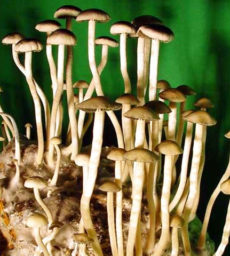
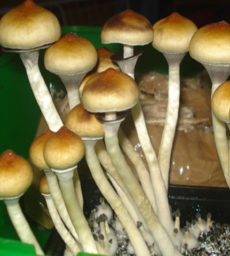
StarGazer Spores
$19.98 – $217.50StarGazer Spores
StarGazer Spores mushrooms and their spores are also some of the most sought after psilocybe cubensis magic mushrooms ever found. Spores from the StarGazer Spores mushroom are available here at SporeStore.com because you asked for them! Find both mushroom spore syringes and also mushroom spore prints. This psilocybe cubensis magic mushroom was first discovered on a farm growing in a pile of dung and straw as its mushroom substrate in Brazil. There is no psilocybin or psilocin contained within magic mushroom spores, making them completely legal to purchase and posses in most jurisdictions throughout the USA. As well as make sure to check your local laws before ordering. The original StarGazer Spores mushroom spores’ genetics from the true StarGazer Spores psilocybe cubensis mushrooms from Brazil are brought to you by SporeStore.com, the leader in mushroom spores.
Spores from this strain are in abundance as it’s a healthy spore depositor.
StarGazer Spores magic mushrooms are easy to grow. Check your local mushroom growing laws. Growing mushrooms for identification and taxonomy purposes? We have your spores!
In addition to the StarGazer Spores spores, here are some other mushroom spores that you may be interested in reviewing: Alacabenzi mushroom magic spores, B+ mushroom spores which is also called B Plus mushroom spores, Malaysia Spores mushroom spores, PES Hawaiian mushroom spores, Ecuador spores
Furthermore check out our new Mushroom Grinder!
Mushroom Capsules found here…
More Detail:
Habitat: Bovine, Equine Dung and Enriched Soils
Climate: Subtropical
Strain Origin: Unknown
Cap: 50+ mm in diameter, convex to broadly convex to plane at maturity. Reddish cinnamon brown maturing to golden brown to light yellow because the surface is dry with pronounced and persistent remnants of universal veil on cap (spots) and the flesh is white soon bruising bluish green.
Stem: 125+ mm in length, yellowish. Flesh bruising bluish green where injured. Persistent membranous annulus (ring) from partial veil that becomes dusted with purple brown spores at maturity.
Gills: Attachment adnate to adnexed. Grayish coloration in young fruit bodies becoming nearly black in maturity.
Spores: Dark purplish brown, subellipsoid on 4-spored basidia
Storage: Store in a dark, cool and dry place and use within six months after delivery!
Taxonomy:
Kingdom: Fungi
Division: Basidiomycota
Class: Agaricomycetes
Order: Agaricales
Family: Strophariaceae
Genus: Psilocybe
Spores: purplish brown to dark brown, 11.5 – 17 x 8 – 11 µm, ellipsoidHabitat and distribution in nature:
Rye grain, wheat straw, horse or cow manure. This species can be found in the subtropical and tropical climate zones all around the globe under the following conditions: Spawn run incubation: 28 °C | Primordia formation: 23.3 – 25.6 °C | Fruiting: 23 – 26 °C
A 2011 study also found that more than a year after participants had a single psilocybin experience, their self-reported measures of openness remained significantly elevated, which researches in this study and beyond attribute to a somewhat mysterious but powerful aspect of a mushroom trip: the mystical experience.
In this case, a mystical experience is defined as “feelings of unity and interconnectedness with all people and things, a sense of sacredness, feelings of peace and joy, a sense of transcending normal time and space, ineffability, and an intuitive belief that the experience is a source of objective truth about the nature of reality.” The religious identification of people who have reported having a mystical-type experience during a mushroom trip span the spectrum, but interestingly the profundity of such experiences don’t seem to correlate to religious belief—even atheists have reported the importance of their psilocybin-induced mystical experiences. Additionally, research has shown that the more intense the mystical experience, the greater the positive, long-term changes a person sees.
These subjective effects, such as feelings of interconnectedness, are likely a result of psilocybin’s ability to decrease the interconnectivity of integration hubs in the brain. In plain speak, that means psilocybin allows for more “cross-talk” between regions of the brain that are typically segregated. Researchers speculate that this enables a state of “unconstrained cognition,” meaning the ways we typically organize, categorize, and differentiate the aspects of conscious experience are broken down, and thinking becomes more flexible. To understand how this might be beneficial, it helps to know that similar brain activity patterns are also observed during various states of meditation.
Habitat: Bovine, Equine Dung and Enriched Soils
Climate: Subtropical
Strain Origin: Unclear, possibly Brazil
Cap: 25-50+ mm in diameter, convex to broadly convex to plane at maturity often with persistent acute umbo (nipple). Reddish cinnamon brown maturing to golden brown to light yellow with nearly white edges. Surface dry lacking remnants of universal veil on cap (spots). Flesh white soon bruising bluish green.
Stem: 150+ mm in length, yellowish. Flesh bruising bluish green where injured. Persistent membranous annulus (ring) from partial veil that becomes dusted with purple brown spores at maturity.
Gills: Attachment adnate to adnexed. Grayish coloration in young fruit bodies becoming nearly black in maturity.
Spores: Dark purplish brown, subellipsoid on 4-spored basidia
Habitat: Bovine, Equine Dung and Enriched Soils
Climate: Subtropical
Strain Origin: Unclear, possibly South America.
Cap: 25-50+ mm in diameter, convex to broadly convex to plane at maturity often with persistent acute umbo (nipple). Reddish cinnamon brown maturing to golden brown to light yellow with nearly white edges. Surface dry lacking remnants of universal veil on cap (spots). Flesh white soon bruising bluish green.
Stem: 150+ mm in length, yellowish. Flesh bruising bluish green where injured. Persistent membranous annulus (ring) from partial veil that becomes dusted with purple brown spores at maturity.
Gills: Attachment adnate to adnexed. Grayish coloration in young fruit bodies becoming nearly black in maturity.
Spores: Dark purplish brown, subellipsoid on 4-spored basidia
-
Sale!


Bitcoin SporeStore Tshirt
Original price was: $28.97.$21.97Current price is: $21.97.Bitcoin SporeStore Tshirt
Bitcoin SporeStore Tshirt Stealth Grey Hidden Spore Coin T-Shirt (Size L). These shirts are super soft and really good quality. There’s a special surprise when you open your order. Look closely at the logo!
These shirts only come in size Large for now. Represent and show those around you how you feel about bitcoin and shrooms. Enough said. This teeshirt or t-shirt shows your loyalty to both shrooms and Bitcoin!
Bitcoin will make us all happy and wealthy. Bitcoin will set our monetary system free.
A 2011 study also found that more than a year after participants had a single psilocybin experience, their self-reported measures of openness remained significantly elevated, which researches in this study and beyond attribute to a somewhat mysterious but powerful aspect of a mushroom trip: the mystical experience.
In this case, a mystical experience is defined as “feelings of unity and interconnectedness with all people and things, a sense of sacredness, feelings of peace and joy, a sense of transcending normal time and space, ineffability, and an intuitive belief that the experience is a source of objective truth about the nature of reality.” The religious identification of people who have reported having a mystical-type experience during a mushroom trip span the spectrum, but interestingly the profundity of such experiences don’t seem to correlate to religious belief—even atheists have reported the importance of their psilocybin-induced mystical experiences. Additionally, research has shown that the more intense the mystical experience, the greater the positive, long-term changes a person sees.
These subjective effects, such as feelings of interconnectedness, are likely a result of psilocybin’s ability to decrease the interconnectivity of integration hubs in the brain. In plain speak, that means psilocybin allows for more “cross-talk” between regions of the brain that are typically segregated. Researchers speculate that this enables a state of “unconstrained cognition,” meaning the ways we typically organize, categorize, and differentiate the aspects of conscious experience are broken down, and thinking becomes more flexible. To understand how this might be beneficial, it helps to know that similar brain activity patterns are also observed during various states of meditation.
Bitcoins can be used to buy merchandise anonymously. In addition, international payments are easy and cheap because bitcoins are not tied to any country or subject to regulation. Small businesses may like them because there are no credit card fees. Some people just buy bitcoins as an investment, hoping that they’ll go up in value.
-
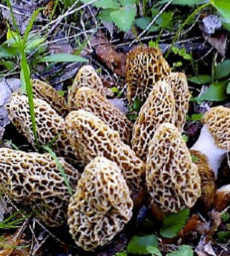
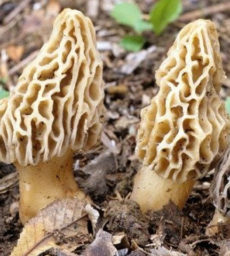
White Morel Spores (Morchella)
$14.95Morchella, the true morels, is a genus of edible mushrooms closely related to anatomically simpler cup fungi in the order Pezizales (division Ascomycota). These distinctive fungi have a honeycomb appearance, due to the network of ridges with pits composing their cap. Morels are sought by thousands of enthusiasts every spring for their supreme taste and the thrill of the hunt, and are highly prized by gourmet cooks, particularly in French cuisine. Due to difficulties in cultivation, commercial harvesting of wild morels has become a multi-million-dollar industry in the temperate Northern Hemisphere, in particular North America, Turkey, China, India, and Pakistan, where these highly prized fungi are found in abundance.
Typified by Morchella esculenta in 1794, the genus has been the source of considerable taxonomical controversy throughout the years, mostly with regards to the number of species involved, with some mycologists recognising as few as three species and others over thirty. Current molecular phylogenetics suggest there might be over seventy species of Morchella worldwide, most of them exhibiting high continental endemism and provincialism.
The genus is currently the focus of extensive phylogenetic, biogeographical, taxonomical and nomenclatural studies, and several new species have been described from Australia, Canada, Cyprus, Israel, North America, Spain and Turkey.
-
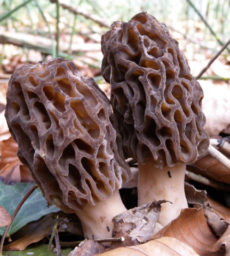
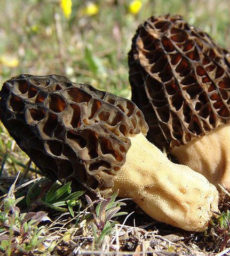
Black Morel Spores (Morchella Importuna)
$14.95 – $29.95Cultivation Difficulty: Difficult
Type: Edible
Substrate: Grass seed, hardwood sawdust
Colonization/Fruiting Temperatures: 70-75F/40-60F
Sclerotia Formation Temperature: 60-65FLandscape morels are considered good candidates for cultivation since they don’t appear to be dependent on seed plants for fruiting. Morchella importuna is fairly common in the northwest of North America with unconfirmed reports in the Midwest and East. It is usually found in gardens, planters and landscaping sites in early spring.
The morel strain provided here was isolated from a wild Oregon, USA specimen and successfully fruited in a disturbed garden habitat in March 2004. This sample was previously provided as “Morchella elata group” but was recently confirmed to be Morchella importuna through genetic analysis.
Currently, there is no reliable method of fruiting morels under laboratory conditions. We offer this species for experimental purposes and make no guarantees beyond the viability of the culture and its ability to form sclerotia. Outdoor cultivation is recommended for the highest chance of success.
See also Morchella rufobrunnea – Yellow Landscape Morel.
The formation of sclerotia is widely accepted as the preliminary stage to the formation of morel mushrooms. A morel sclerotium is a hard mass of compressed mycelium that forms underground during the late spring and summer. It is thought to be a dormant structure in the morel lifecycle that allows it to over-winter. The sclerotium can then quickly spring to life with the warm spring rains.
Current successful cultivation method:
Using a presealable MycoBag(TM) with self-healing injection port, place a cup or so of soaked and well drained grass seed on the bottom near the injection site and a thick layer of moist hardwood sawdust on top. Seal with an impulse sealer and sterilized at 15psi for 2-3 hours. After cooling, inject the culture syringe into the grass seed and let it colonize at 60-65F for at least 3 weeks. Do not mix the grass seed with the sawdust. The morel mycelium will feed on the grass seed and use that energy to grow sclerotia in the nutrient poor sawdust. There should be plenty of the small orange sclerotia visible before planting outside. In November-January, dig a small depression in a shady garden area and sprinkle it heavily with garden lime. Dump out the sawdust layer into the depression and cover it with garden soil mixed with a few handfuls of lime and ignore it. With luck, morels will appear in the spring. Alternative methods recommend mixing wood ash with the sclerotia as black morels are often associated with burn sites. This was not attempted with this strain.
The above method can be attempted with jars but the grass seed should be placed on top of the sawdust instead of the bottom.
We would be interested in any reports of success with this culture.
-
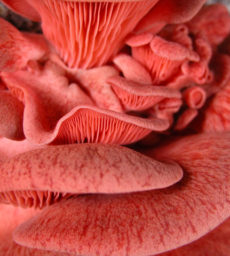
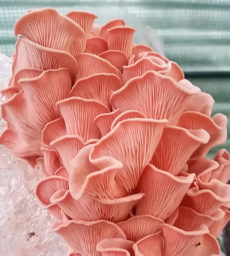
Oyster Spores
$14.95Oyster Spores
Oyster Spores Mushrooms are a fantastic and super easy mushroom to learn on and grow.
Cultivation Difficulty: Easy
Type: Edible
Substrate: Pasteurized straw, wood chips, sawdust, various grains, coffee grounds, agricultural waste, newspaper and cardboard.
Colonization/Fruiting Temperatures: 75-85F/50-75F
Available In: Culture Syringe, Culture Slant
Oyster Spores magic mushrooms are easy to grow. Check your local mushroom growing laws. Growing mushrooms for identification and taxonomy purposes? We have your spores!
In addition to the Oyster Spores spores, here are some other mushroom spores that you may be interested in reviewing: Alacabenzi mushroom magic spores, B+ mushroom spores which is also called B Plus mushroom spores, Malaysia Spores mushroom spores, PES Hawaiian mushroom spores, Ecuador spores
Furthermore check out our new Mushroom Grinder!
Mushroom Capsules found here…
The Phoenix Oyster Spores mushroom is an aggressive mushroom that fruits easily on a wide range of substrates. This is the most popular mushroom for beginners and is the top choice for introductory mushroom cultivation demonstrations.
Fresh oyster mushrooms seen at markets are most often this species. The aggressive and productive nature that makes this mushroom popular also makes it quick to decay after maturity. Harvested mushrooms may continue to grow even if refrigerated and often spontaneously form new primordia. Mushrooms should be consumed or dried within days of harvest for best quality.
These mushrooms need plenty of fresh air to develop normally. High carbon dioxide levels from mushroom metabolism will accumulate in sealed growing environments and can reduce cap size and elongate stems severely.
Oyster mushrooms, the common name for the species Pleurotus ostreatus, are one of the most common types of cultivated mushrooms in the world. They’re also known as pearl oyster mushrooms or tree oyster mushrooms. The funghi grow naturally on and near trees in temperate and subtropic forests around the world, and they’re grown commercially in many countries. Oyster mushrooms are eaten in a variety of cuisines and are especially popular in Chinese, Japanese, and Korean cooking. They can be dried and are typically eaten cooked.
What Are Oyster Spores Mushrooms?
Oyster mushrooms are beloved the world over for their delicate texture and mild, savory flavor. The mushrooms typically have broad, thin, oyster- or fan-shaped caps and are white, gray, or tan, with gills lining the underside. The caps are sometimes frilly-edged and can be found in clusters of small mushrooms or individually as larger mushrooms. Oyster mushrooms are more expensive than white button mushrooms but less so than rarer mushrooms like morels, and take little prep since they can be used whole or chopped. They are even used to make mycelium furniture and many other products.
How to Cook With Oyster Mushrooms
Like all mushrooms, oyster mushrooms act almost like sponges, soaking up any water they come into contact with. Don’t leave them sitting in water, even for the sake of cleaning them. Cultivated oyster mushrooms usually don’t need much cleaning—simply wipe off any bits here or there with a dry paper towel. A damp paper towel can be used on extra dirty mushrooms.
While you can eat oyster mushrooms raw and they can be quite pretty added to salads, they tend to have a slightly metallic flavor when uncooked. Cooking brings out their delicate flavor, turning their spongy texture into something uniquely velvety. We recommend using oyster mushrooms for cooked dishes and using button mushrooms for salads and other raw dishes.
Dried oyster mushrooms don’t need to be soaked to be rehydrated the way other dried mushrooms do—just add them to the dish, and they will soak up liquid right away
What Do Oyster Spores Mushrooms Taste Like?
Oyster mushrooms tend to have a subtle, savory anise flavor. Because their flavor is mild, without the strong earthiness of some mushroom varieties, they work well in a range of different dishes. Oyster mushrooms also take on a tender, pleasing texture when cooked. Cooking methods like frying, roasting, and grilling can retain more texture in the mushrooms while braising and sautéing makes them softer.
Oyster Spores Mushroom Recipes
One of the most popular ways to cook oyster mushrooms is to stir-fry or sauté them. This requires a preheated hot pan, a small amount of liquid, and stirring. Make sure to give them space so their moisture can cook off, that way they will truly sauté rather than steam. Serve as a side dish or use in sauces, stir-fries, pastas, risotto, or even to top toast.
Because they get so silky when cooked, oyster mushrooms respond well to braising, too. Add them to soups and stews or sauces. The mushrooms can also be grilled whole on skewers, roasted, or dredged in a crispy coating and deep-fried.